-
Membership
Membership
Anyone with an interest in the history of the built environment is welcome to join the Society of Architectural Historians -
Conferences
Conferences
SAH Annual International Conferences bring members together for scholarly exchange and networking -
Publications
Publications
Through print and digital publications, SAH documents the history of the built environment and disseminates scholarship -
Programs
Programs
SAH promotes meaningful engagement with the history of the built environment through its programsMember Programs
-
Jobs & Opportunities
Jobs & Opportunities
SAH provides resources, fellowships, and grants to help further your career and professional life -
Support
Support
We invite you to support the educational mission of SAH by making a gift, becoming a member, or volunteering -
About
About
SAH promotes the study, interpretation, and conservation of the built environment worldwide for the benefit of all
Prados and Plazas: Investigations into the Cultural Resources and Key Urban Elements of the Island
Danielle S. Willkens is the 2015 recipient of the H. Allen Brooks Travelling Fellowship. All photographs and videos are by the author, unless otherwise noted.
Home to some of the first permanent structures in the New World, the architecture of Cuba is characterized by myriad styles and influences, ranging from Spanish colonial and Baroque to neoclassicism and experimental modernism. With nine designated UNESCO World Heritage Sites, Cuba has one of the highest concentrations of recognized, ‘”globally significant” sites in the Americas.1 There are seven cultural sites that include four urban centers, fortifications, and two sites tied to built interventions that supported the nation’s agricultural endeavors: Old Havana and its Fortification System (1982), Trinidad and the Valley de los Ingenios (1988), Urban Historic Centre of Cienfuegos (2005), Historic Centre of Camagüey (2008), San Pedro de la Roca Castle in Santiago de Cuba (1997), Archaeological Landscape of the First Coffee Plantations (2000), and the Viñales Valley (1999) (Figures 1–5 and Videos 1–2). The eastern side of the island is home to the two designated UNESCO sites for natural significance, Desembarco del Granma National Park (1999) and Alejandro de Humboldt National Park (2001). Furthermore, the island has sites on the Tentative List: the Ciénga de Zapata National Park, the National Schools of the Arts (discussed in last month’s blog post), Cubanacán, and the Reef System in the Cuban Caribbean. With such a wealth of historical and natural resources, Cuba is primly situated to execute profitable endeavors in cultural heritage exploration and eco-tourism. The quickly rising visitor numbers, however, are outpacing critical elements of infrastructure and few of the nation’s current construction or restoration projects focus efforts on the cultivation of resources specifically for locals. Exploring the island through the lens of tourism, this post will explore the surge in visitor numbers in the last two decades as well as the urban kit-of-parts found in many Cuban cities, making key sites relatively easy to identify and navigate. The sites discussed in this post, and many more, are located on this Google map for reference.
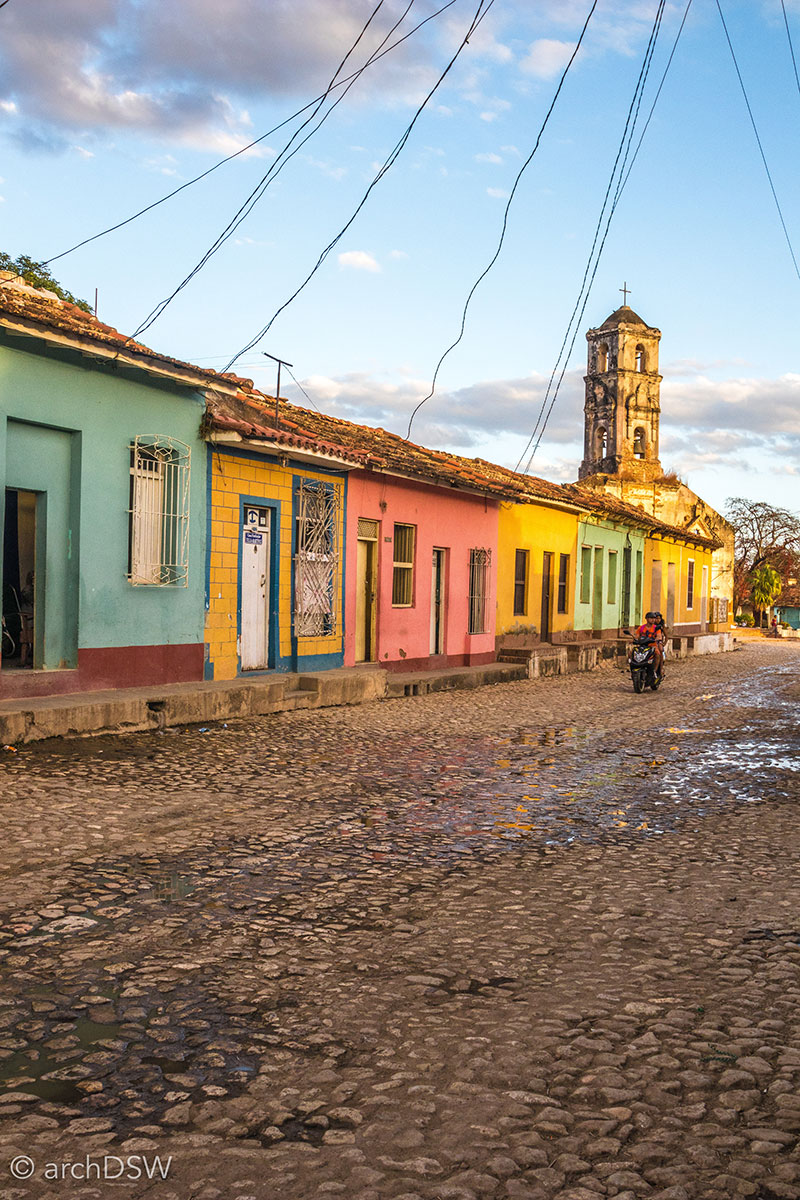
Figure 1. A view down one of Trinidad’s residential streets, looking towards the ruined 18th-century church Santa Ana. The majority of homes along this route are casa particulars.
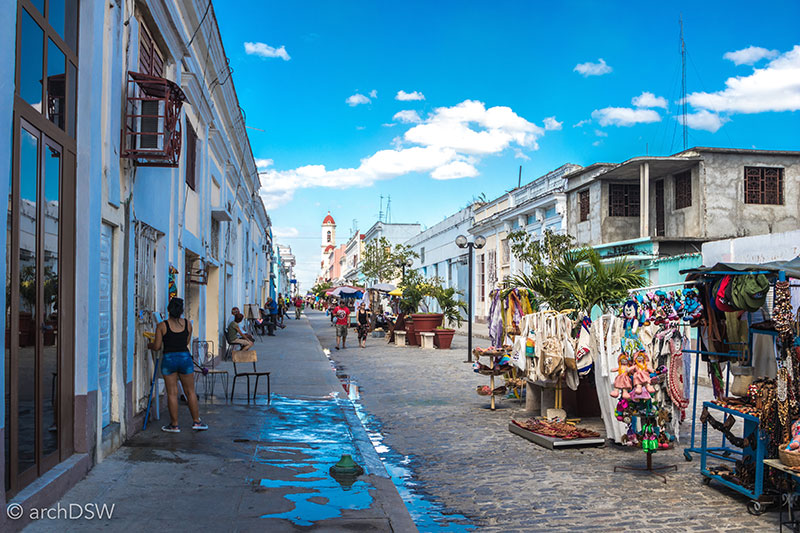
Figure 2. A view from the bay of Cienfuegos looking forwards Plaza Mayor, the historic core of the city.
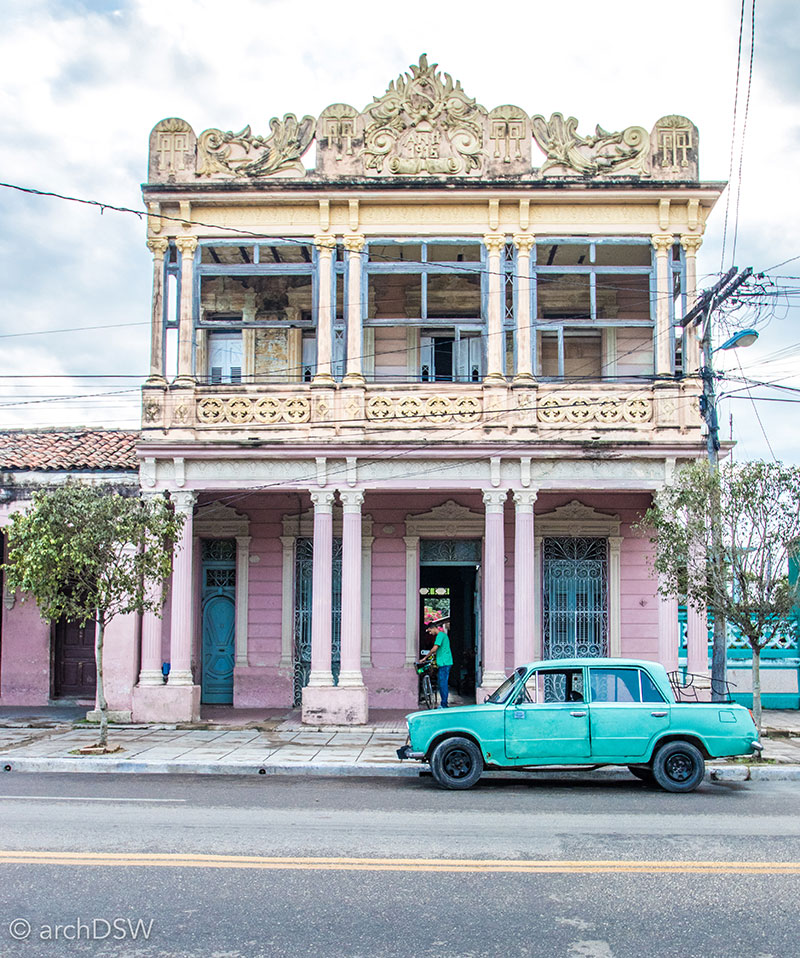
Figure 3. Camagüey’s Avenida de la Libertad is filled with an array of eclectically stylized one and two-story structures, all unified by their use of a protective colonnade.
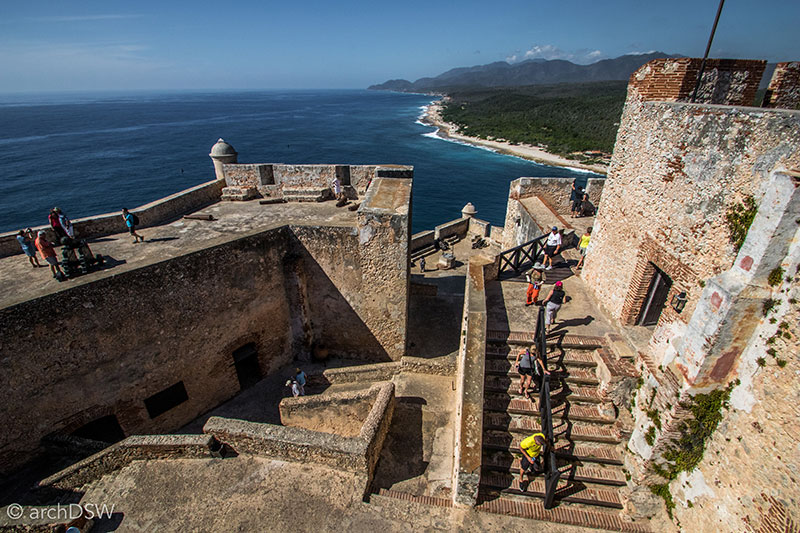
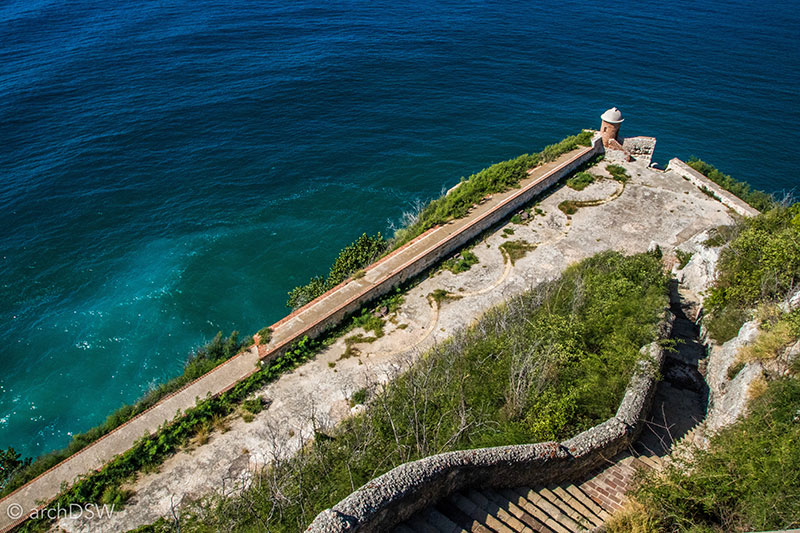
Figures 4 and 5. Views of El Morro (c.1639), one of the many fortifications in the nation executed by the Antonelli family of Milan. Portions of the castle are open to visitor exploration while others, such as the lowest sections that negotiate the rocky cliffs, are off limits.
Video 1. The sunset ceremony at El Morro in Santiago de Cuba.
Video 2. Scenes of the Cuban countryside in Pinar del Rio and Viñales.
The Rising Tide of Tourism
At present, there is only one ground crew dedicated to inbound flights, one for outbound flights, and two baggage carousels in the primary international terminal of Havana's airport. Therefore, as cranes operate above the adjacent structure that is under construction and poised to accommodate the expansion of traveler numbers, the current terminal seems to be under rapidly rising strain. In the recent months, the surge is the direct result of the new influx of travelers from the United States who are arriving to the capital city on one of the many airlines now offering direct commercial flights from states like New York, Florida and even Alaska. On December 1st, I had the fortune of being onboard Delta's first commercial flight in fifty-five years from Miami to Havana. The company celebrated with true pomp and circumstance, including guayaba cookies and café con leche at the gate, a speech by Delta's manager for operations in Latin America, and a gift box for travelers. Ribbon cutting ceremonies occurred at both the Miami and Havana sides of the journey, trucks from Miami-Dade Fire Rescue Department christened the plane with water canons upon departure, and a national news team covered the Havana arrival. Despite the excitement for daily commercial flights, provided by companies such as Delta, American Airlines, Spirit, and JetBlu, the facilities at Havana's José Martí airport are not yet equipped to handle the surge in traffic. For example, in December and January, airport travelers experienced intermittent brownouts as well as regular delays for inbound and outbound flights, ranging from one to three hours.
According to the Cuban Ministry of Tourism (MINTUR), Canadians still comprise the largest percentage of the island’s visitors. However, the majority of these visitors do not spend their time enjoying Cuba’s rich history and natural landscapes but, instead, lounging on Cuban coastal resorts, such as those found on the Varadero peninsula east of Havana. In the last two years, there has been an 80% increase in American visitors and, due to the current regulations, these visitors are spending their time at cultural institutions and engaged in professional exchanges instead of indulging in beach holidays. Following the Revolution in 1959 and the trade embargo imposed a year later, Americans were largely barred from traveling to Cuba. Exceptions were granted for those who carried a special license issued by the U.S. government, traveled with a registered people-to-people educational tour, or [precariously] circumnavigated the system by traveling through a gateway country such as Mexico or Canada. On January 16, 2016, these restrictions were amended to accommodate twelve special categories, found here. My travels for the SAH Brooks Travelling Fellowship fall under professional research and to ensure proper adherence to the regulations that state that itineraries can be audited up to five years after the conclusion of travels, it is important to keep meticulous records of day-to-day activities.
In order to accommodate the sharp rise in visitor numbers in the 21st century, banners and videos in the airports and around the capital advertise that the nation plans to add approximately 50,000 new rooms by 2020 and 100,000 new rooms by 2030 in coordination with the National Plan for Economic and Social Development. For reference, the number of rooms for foreign tourists in 1990 was estimated at 12,000 and this grew to 35,000 by 1999.2 The initial expansion of tourist accommodations was due to a law in 1995 that allowed select foreign investments on the island and in the last two decades Cuba has welcomed foreign conglomerates such as Spain’s Iberostar and Melià, France’s Accor, Canada’s Royalton, China’s Beijing Enterprises Holdings Ltd. and, in the last two years, even American newcomers like the Starwood Group. In addition to foreign investors, the hotel boom on the island has been facilitated by hospitality projects associated with the state’s hotels, the Gran Caribe brand, and the tourism branch of the Cuban military known as Gaviota. Most of the new projects are located in Havana or coastal resorts but a new set of golf course resorts are under review for Chorreara-Ancón near Trinidad, potentially changing traffic patterns and visitor numbers to the aforementioned USNECO World Heritage city. There is also a new market for boutique hotels in cities beyond the capital, such as Camagüey, Cienfuegos, Santiago de Cuba, and Viñales. Typically defined as a structure with less than 100 rooms, it is easy to imagine how these hotels will change the urban fabric and scale of low-rise cities. Instead of climbing historic church towers to get the best views of a city, some visitors may choose to solely experience the view from the rooftop terrace of their hotel, widening the already-expansive gap in Cuba between sites for locals and those for tourists (Figures 6 and 7).
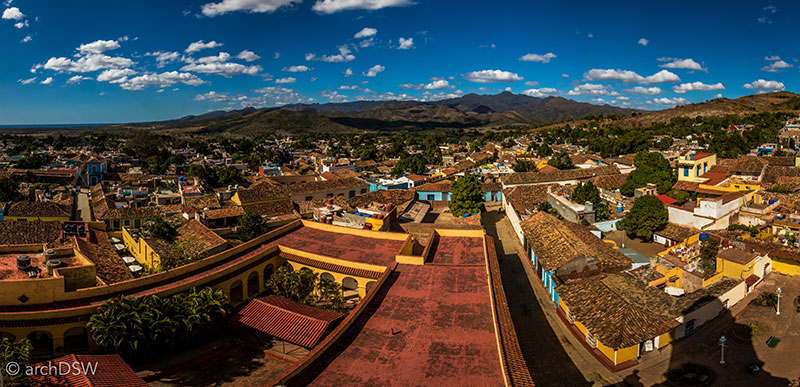
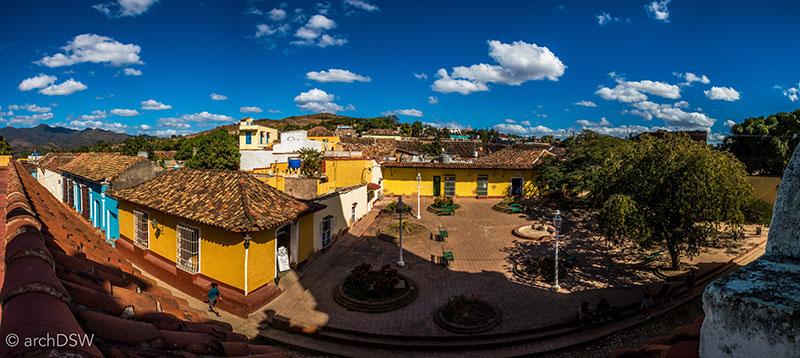
Figures 6 and 7. A view from the tower of Igelsia y Convento de San Francisco, now home to a regional museum of the Revolution, the Museo de la Lucha contra Bandidos.
Furthermore, the ambitious plans for growth in tourists’ accommodations by 2020 and 2030 exist in stark contrast to the housing crisis around the nation, particularly in the capital. Cuban architect, urbanist and University of Havana Professor Miguel Coyula estimates that although there are approximately 17,000 people in temporary housing, designed within the standardized specification for 25m2 area with a bathroom, more than 140,000 are in need of housing.3
Urban Rules and Resources
It is surprising that there are not any dedicated urban planning programs at Cuban universities, especially considering that the island’s cities have some of the most compelling urban histories that were shaped by rules from the colonial period and adapted into ever-resilient centers for commerce, culture, and recreation. In many ways, Cuban cities have a kit of parts consisting of portales [arcades], plazas, and prados. In many cities, the best way to first survey the surroundings is from the bell tower of a local church. For only a few CUCs, one can climb between worn stonewalls and walk on precarious wooden steps to achieve prized views. Peering across surrounding plazas and over the roofs clad in Spanish tiles, it is possible to get a better understanding of the material fabric of the city as well as the prolific use of inner courtyards to provide light and assist with the circulation of air. Furthermore, these elevated views allow one to see the inventiveness and malleability of Cuban domestic architecture. In various cities, a brief aerial survey shows that roofs were turned into terraces and, over time, one-story homes grew into Escher-esque towers to accommodate growing families (Video 3).
Video 3. Sunset over the Catedral de la Asunción in Parque Céspedes, Santiago de Cuba. The cathedral’s site has been a place of worship since 1522, and the current structure (b. 1766) underwent a substantial restoration program in 2014.
Many of Cuba’s oldest cities were the products of regulations set forth in the New Laws of the Indies in 1573.4 These laws defined elements of urban planning including street width and block size, based upon Roman military encampments. As the laws developed they also defined the appropriate stylistic characteristics of buildings and construction specifications to safeguard against fires and significant earthquake damage. Therefore, these regulations can explain why cities like Havana, Cienfuegos, and Camagüey share a proliferation of portales [arcades] to shade merchants and pedestrians and why cities with different settlement patterns, like Trinidad and Santiago de Cuba, still share similarities in their architectural detailing and use of material. The regulations also established the color palette of the island, requiring saturated colors on buildings to help reduce glare (Figure 8).5
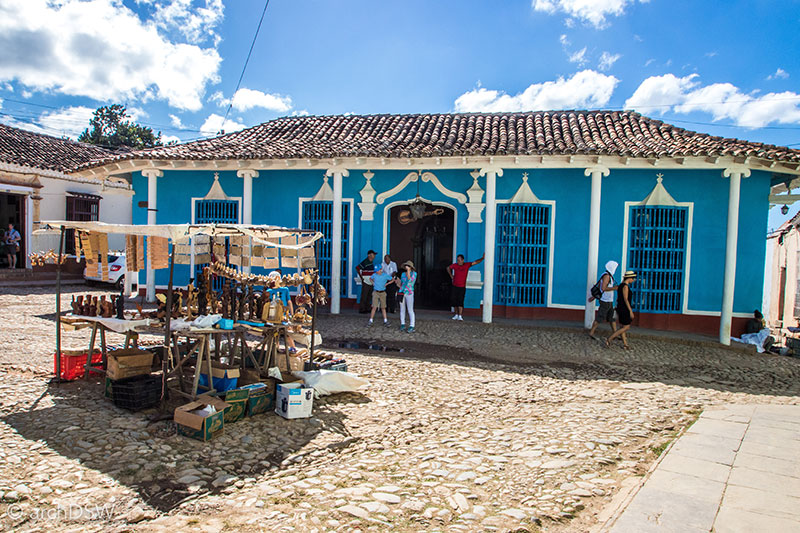
Figure 8. The Casa de la Trova in Trinidad features many of the popular features of early 19th-century colonial architecture: trompe l'oeil marbleizing around window frames and sills as well as the embellishment of volutes on the porch’s structural posts. Although intended to make the simple structural supports look like Ionic columns, the lack of base and classical proportions, such as the use of entasis, make the decorated posts look more whimsical than refined
Few cities strictly adhered to the full extent of the imposed rules, yet these laws served as guiding ordnances for cities. Arcades, plazas, and courtyards can be found throughout the nation; however, each city seems to have a series of local variations driven by topography, access to materials, local vegetation, and microclimate. For example, Holguín became a city of not just one grand plaza but, instead, a series of smaller squares. Here, the number of bicycles and horse-drawn carts outnumber cars. This means that the city is filled with a unique cadence of bicycle bells and clicking hooves that provide a base rhythm to the hourly song of the city's church bells. Few tourists visit this humble city of one and two-story buildings, bypassing it for the coastal resorts of Guardalavaca, but urban development in Holguín managed to balance a relatively uniform, gridded core with a steep change in topography. The summit of Loma de la Cruz was originally an informal pilgrimage site in the late 18th century but in the early 1900s, a full-scale grading project was undertaken to transform the path up the hill into the Escalienata de la Loma. After a strenuous climb, the intrepid are rewarded with a spectacular view of the city and its surrounding region (Figure 9).
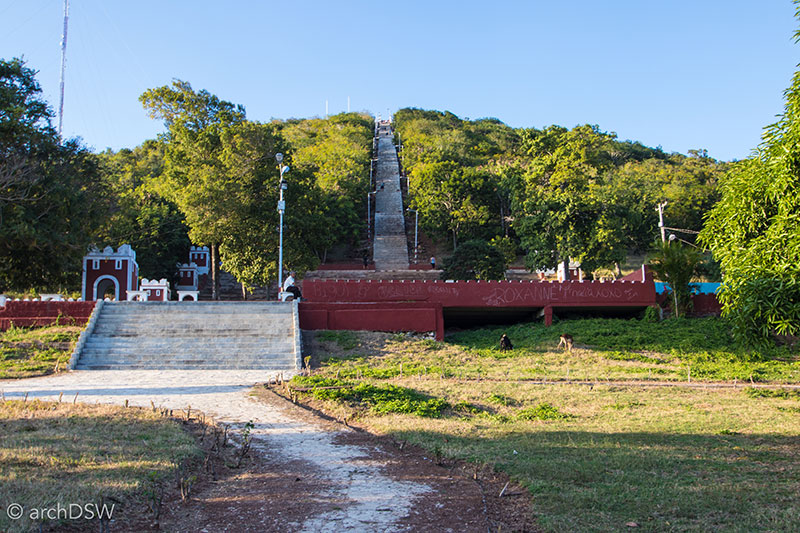
Figure 9. The steep ascent of the Escalienata de la Loma leads to a hilltop plaza.
Another unifying feature of Cuban cities is the plaza. Originally designed as forecourts to churches and municipal spaces for commerce, these urban gathering spaces are still active sites for locals and visitors (Figure 10). The plazas serve an array of functions, acting as the intermittent playgrounds for adjacent primary schools as well as venues for musicians and street performers (Figures 11 and 12).
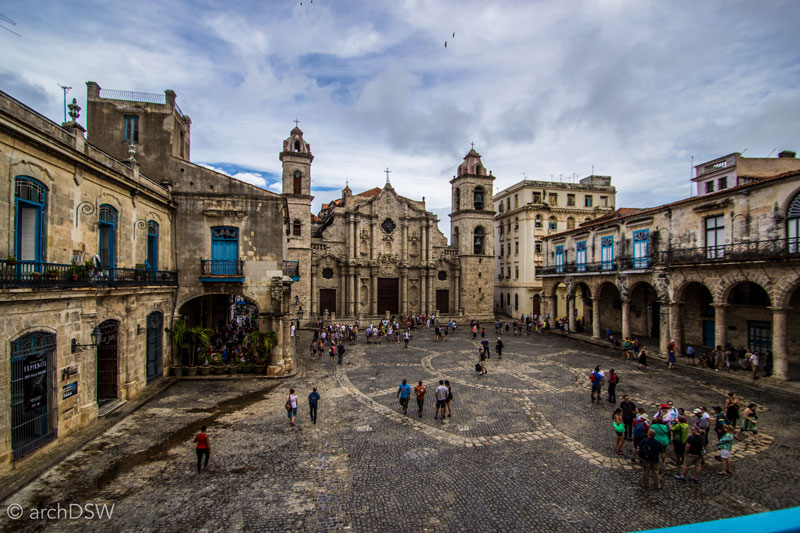
Figure 10. A view of the plaza adjacent to Havana’s Cathedral.
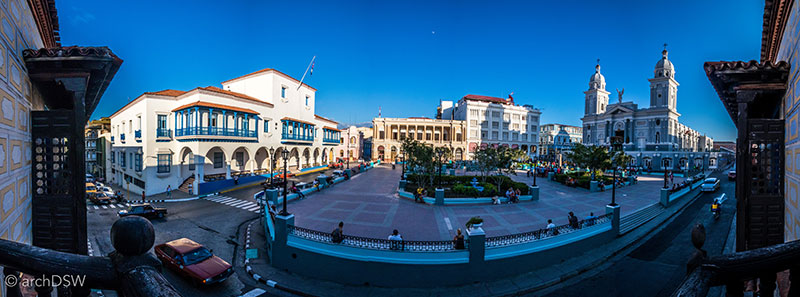
Figure 11. A view of Santiago de Cuba’s Parque Céspedes
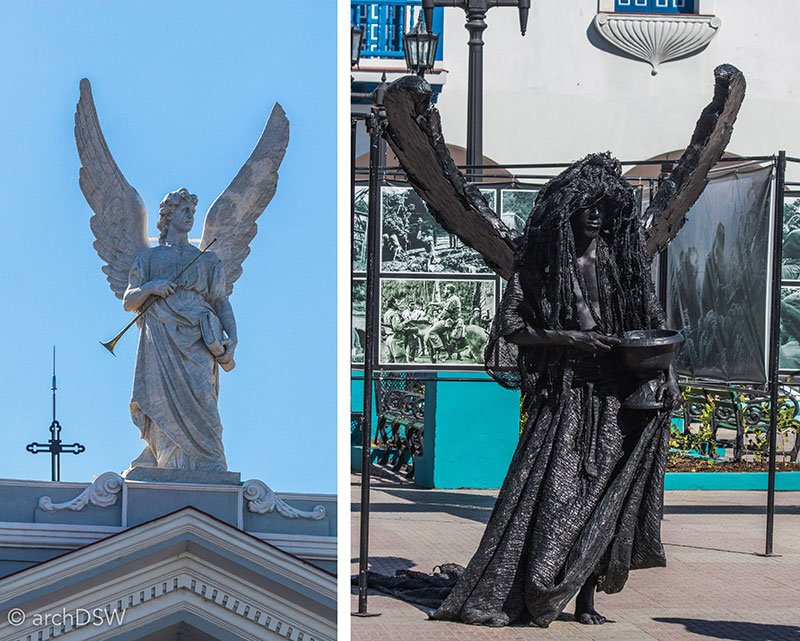
Figure 12. A bold street performer in Santiago de Cuba’s Parque Céspedes braved the unrelenting heat in an entirely black costume that juxtaposed the white angel adorning the recently restored Catedral de la Asunción (b. 1522, rebuilt 1674 and again in 1766 after an earthquake).
As planning projects moved away from centralized courtyards and contained urban squares, several of Cuba’s cities received a new element: the prado. These wide boulevards were developed in the 19th and 20th centuries and function as linear parks as well as shaded places for the circulation of pedestrians and vehicles. In cities like Havana and Cienfuegos, these boulevards were paved with terrazzo and, today, they are prime locations for skateboarders and children racing on rollerblades. In other sites, such as Pinar del Rio, the prados have been revived with new street furniture and art (Figure 13).
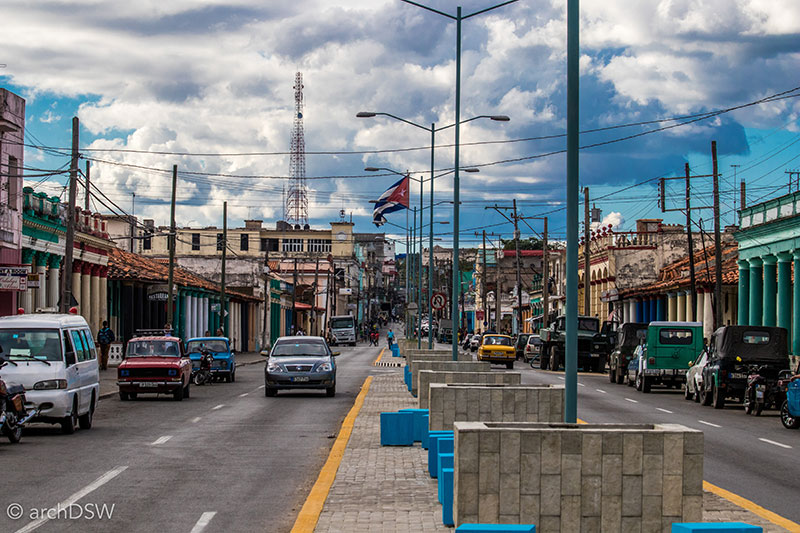
Figure 13. The leisurely qualities of prado in Pinar del Rio have been somewhat interrupted by the boulevard’s connection to the A4, the main highway in western Cuba.
Perhaps one of the best places for a brief study of Cuban urban planning is Cienfuegos. Founded by a colony of French planters from Louisiana, Cienfuegos has one of the most orderly urban centers in Cuba and this is explained by the comprehensive urban plan that was established in 1819. The historic core of the city has gridded arrangement with a series of block-sized parks and the extensive Plaza de Armas, now Parque Martí. Like many of the main plazas in Cuban cities, Parque Martí, is a microcosm for exploring the city’s history and preserved architecture (Figures 14-19). Located around this central plaza are the city’s main historic and cultural sites: the Catedral de la Purísima Concepción (1833–1869), one of the nation’s only preserved triumphal arches, the eclectic Palacio Ferrer (early 1900s) that now houses Casa Provincial de la Cultura and the Teatro Tomás Terry (1886–1889) by Lino Sánchez Mármol. Just blocks away from this plaza it is also easy to navigate to both the Museo Histórico Naval Nacional, on the bay, and the urban artery that connects old Cienfuegos with the southern peninsula of the city.
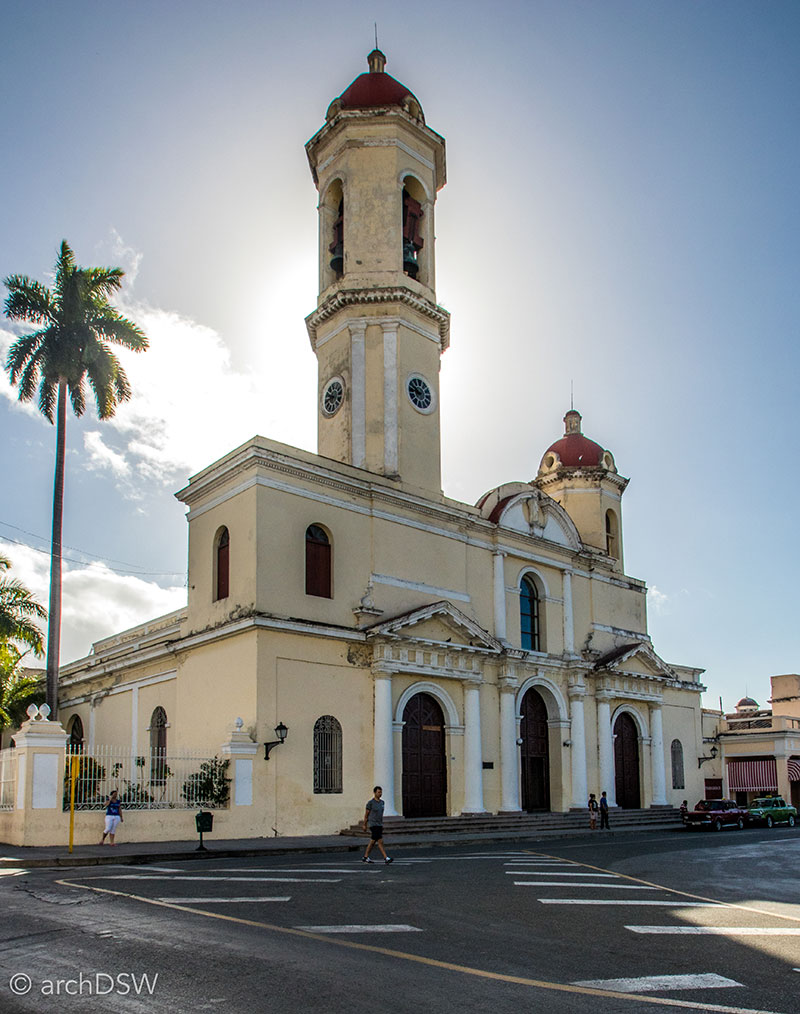
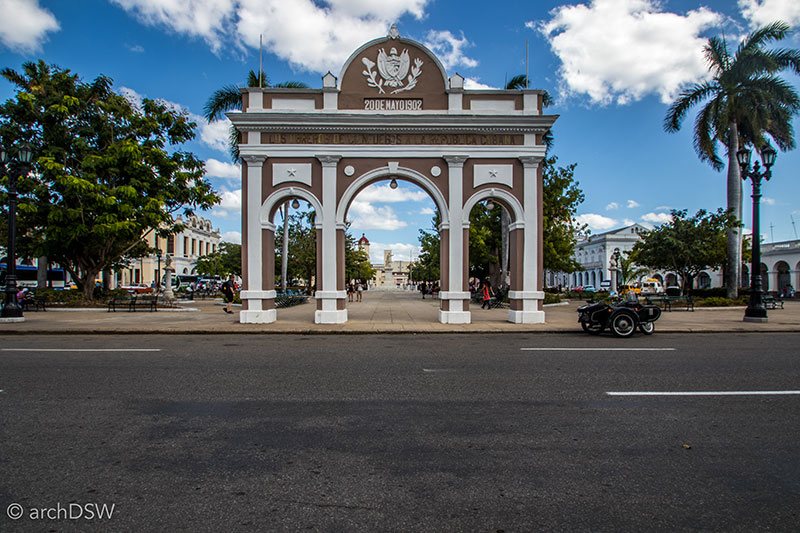
Figures 14 and 15. Anchoring elements of Parque Martí
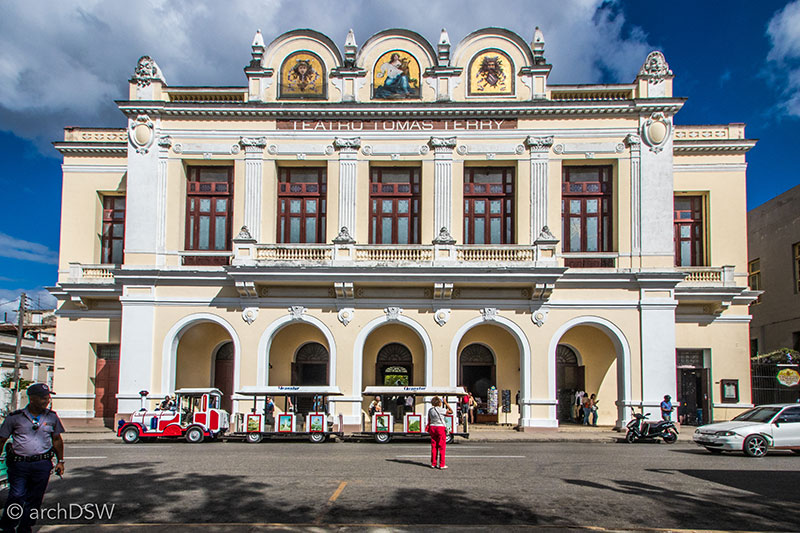
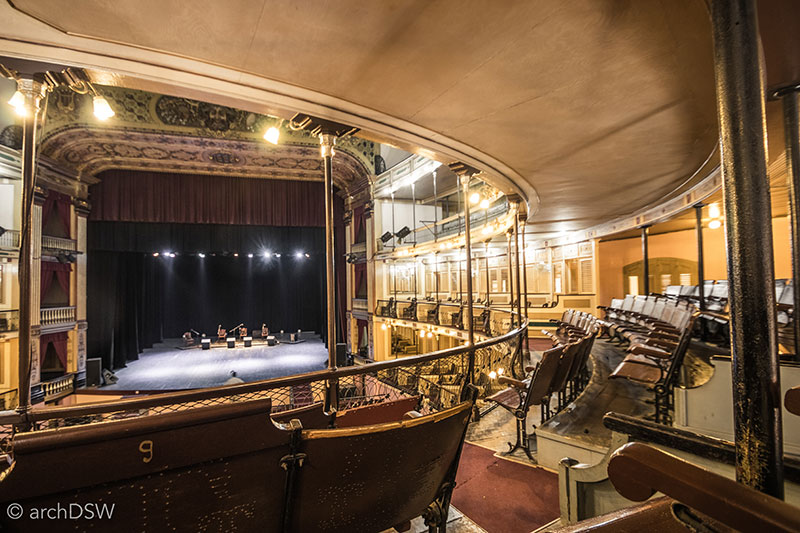
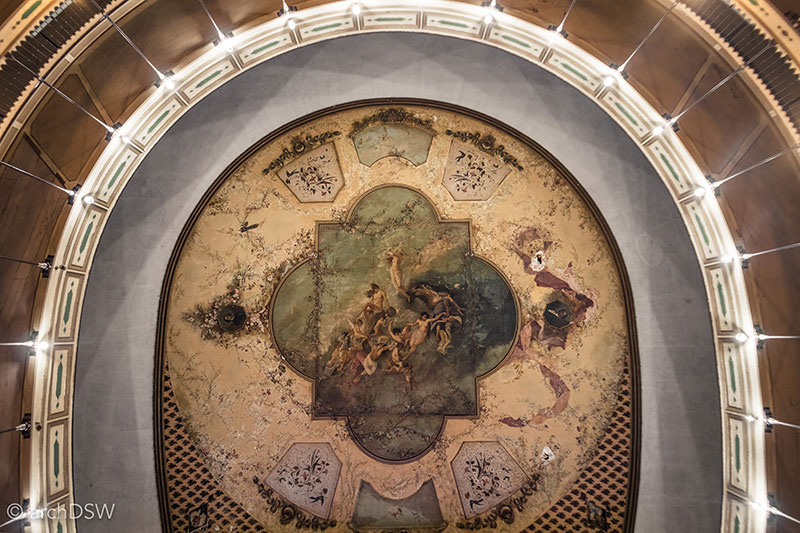
Figures 16–18. The Teatro Tomás Terry in Cienfuegos, largely inspired by the Teatro Sauto (1863) in Matanzas.
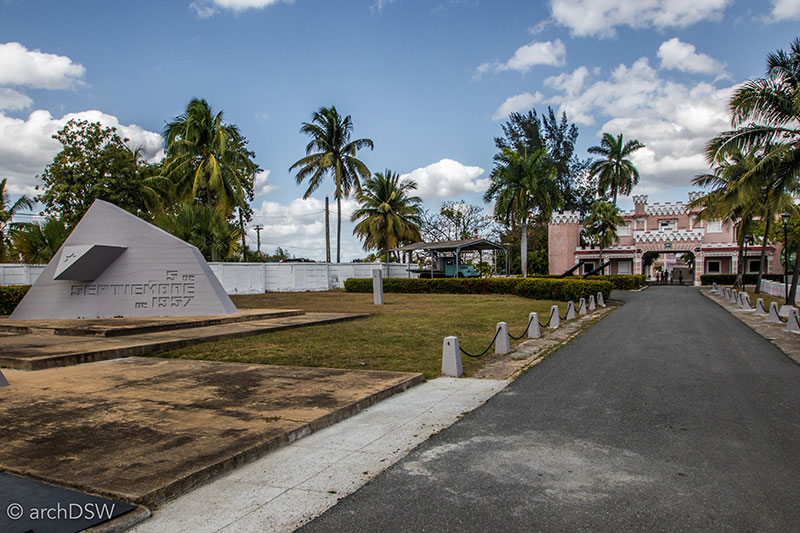
Figure 19. Housed in barracks from the 1930s, the Museo Histórico Naval Nacional opened in the early 1980s and features displays on the region’s naval history, maritime landscape, and the September 1957 insurrection.
As Cienfuegos expanded, the tree-lined allée, the Paseo del Prado, transitioned into a bayside Malecón, stretching to Punta Gorda. Here, much like Havana’s Miramir district, grand homes lined the streets. Anchoring the southern end of the Malecón is the grandiose Palacio de Valle (1912–1917) (Figures 20 and 21). Unparalleled in size or embellishment, this building stylistic hybrid features neo-Moorish, Baroque, and Italianate elements. Sponsored by Spanish businessman Acisclo del Valle, the home’s ostentatious design, paired with the rich material palette of Carrara marble and imported woods and ironwork, is a prime example of real estate speculation during the 'fat cow' era prior to the Depression. The fairytale structure had a tragic turn when Acisclo died just three years after the project’s completion. In 1922, his widow Ampara Suero, left Cuba with the couple's seven children and the abandoned home was unused for over a decade. Batista coveted the site in the 1950s as an ideal location for a casino but the Revolution [thankfully] thwarted these plans. Today, the palacio sits next to the popular Hotel Jagua (1956), another product of Meyer Lansky's Cuban 'entrepreneurialism', the site operates as a restaurant and venue for group events.
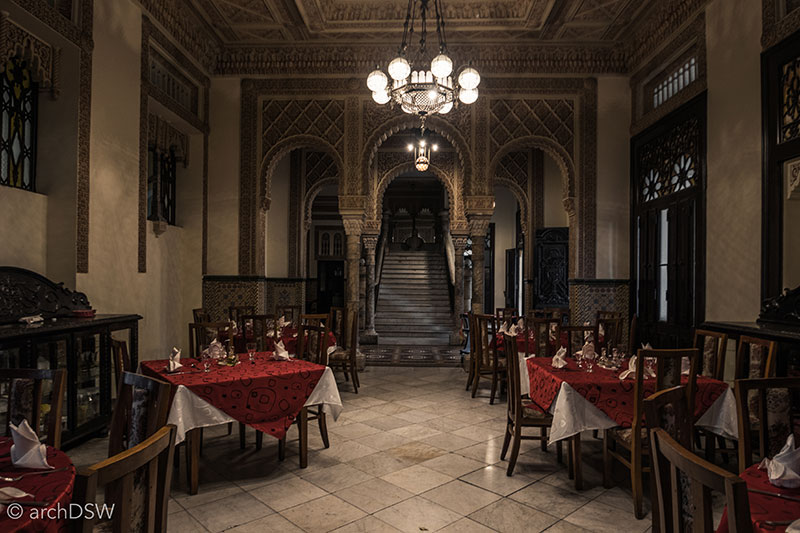
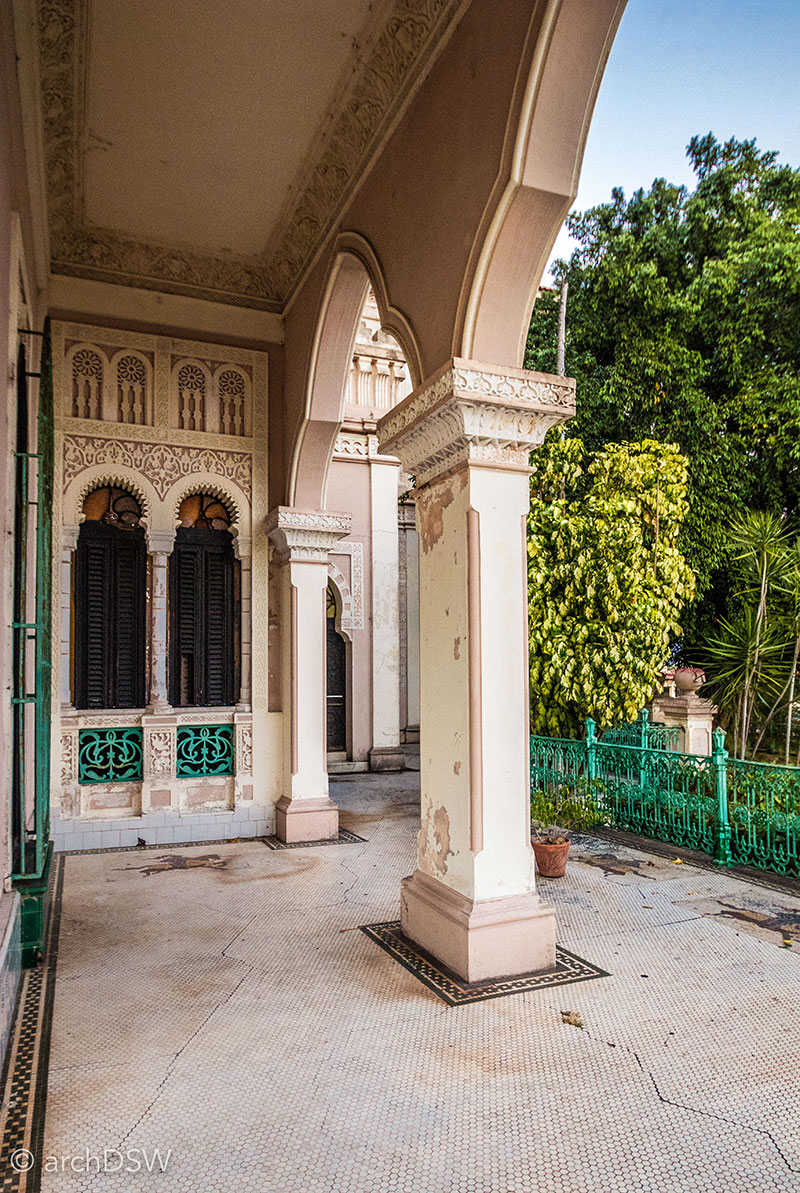
Figures 20 and 21. Obscured by dense vegetation, a comprehensive view of Palacio de Valle is difficult to capture but the building’s ornate details require close inspection both on the interior and exterior.
Architecture [in] Museums 6
As evidenced by the layout of Cienfuegos, the plazas, squares, and prados of Cuba’s cities serve as the primary place to find a particular city’s cultural heritage gems: sacred sites, homes converted to memorialize the life of a national figure, and provincial museums. When exploring Cuba’s cultural heritage it becomes clear, quite quickly, that museums are state run. Therefore, it is not surprising that throughout the island there is a predictable formula for entry. With the exception of larger institutions in the capital city, the museums in the island typically charge 1–2 CUCs for entry and an additional 5 CUCs for a photography permit. Although parks, squares, small cafeterias, and stores were rarely empty, it was not uncommon to be the only person exploring a small museum. If a tour group descended on the site, it was rare that they spent more than an hour so in many of the designated historic sites of Cuba’s smaller cities, I felt like I had private viewings (Figure 22).
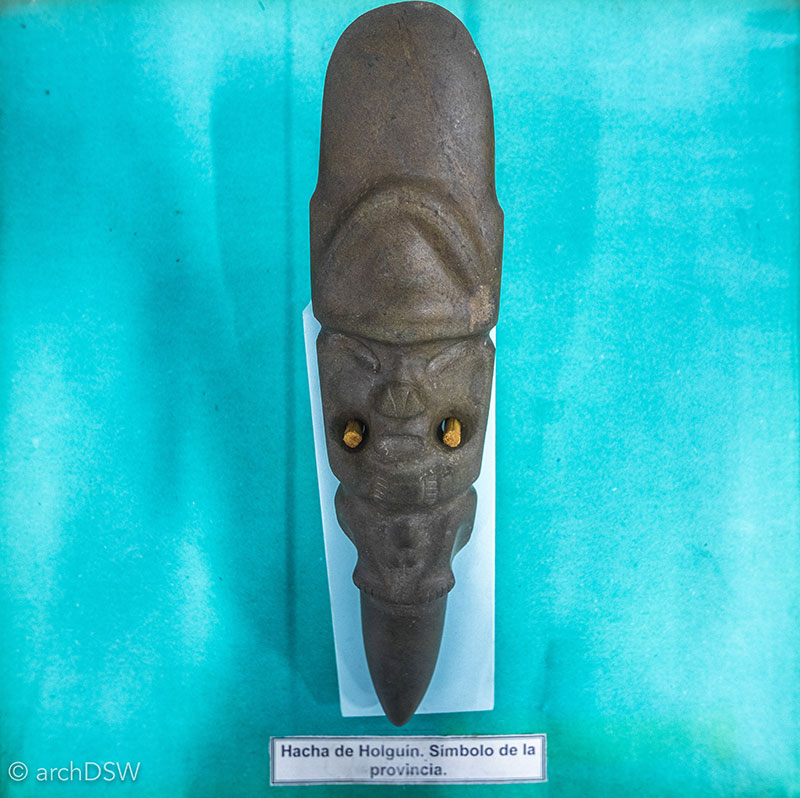
Figure 22. The Hacha de Holguín is a stone axe head from the native Taíno Indians and it is housed in the Museo Provincial, Holguín. The building was constructed in 1860 as home of Spanish merchant Francisco Roldán y Rodríguez but it was converted into barracks for Spanish soldiers during the Ten Years' War, earning the nickname 'La Periquera' [the parrot cage] in reference to the soldiers' bright uniforms. During my visit, a memorial exhibit for the city’s most famous son, Fidel Castro, displaced the Hacha de Holguín. After exploring the museum and realizing that I somehow missed the carved icon, I had the fortune of speaking with the curator who was eager to show me the object, and many others in the museum's extensive storage room, located in the converted carriage house of the building.
The Museo de Arquitectura Colonial in Trinidad’s restored Casa de los Sánchez Iznaga is the only museum in the nation specifically dedicated to architecture (Figures 23–25). In this small but rich museum one can find preserved door hardware, wooden ceiling embellishments, and a series of decorative objects from all over the world, such as tables, chandeliers, and statuettes that illustrate Trinidad's connections to global trading routes in the colonial era. Elements of the building’s restoration were purposefully exposed in certain rooms so that visitors can see the layers of brick and rubble infill that support the structure's walls as well as the 'ghosts' of apertures from earlier time periods in the home's history.
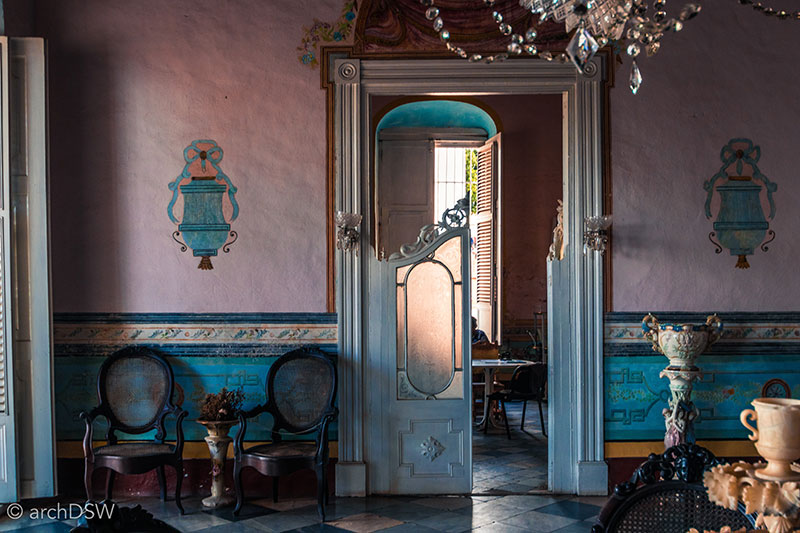
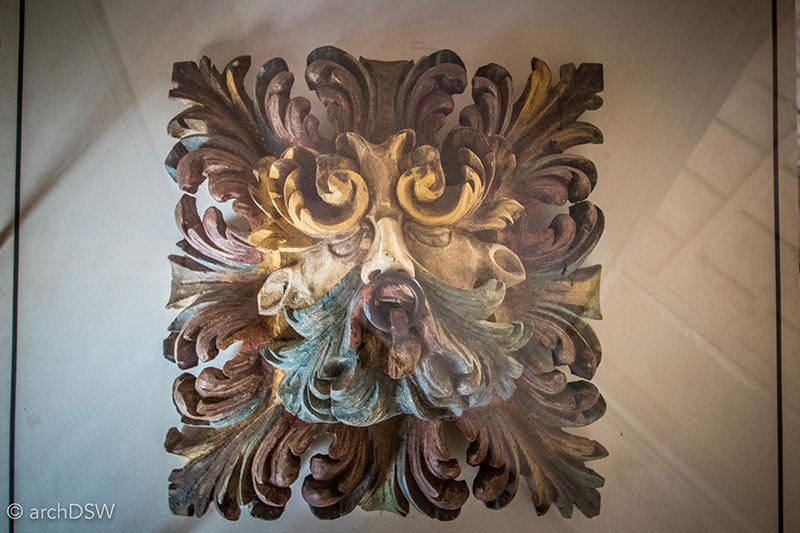
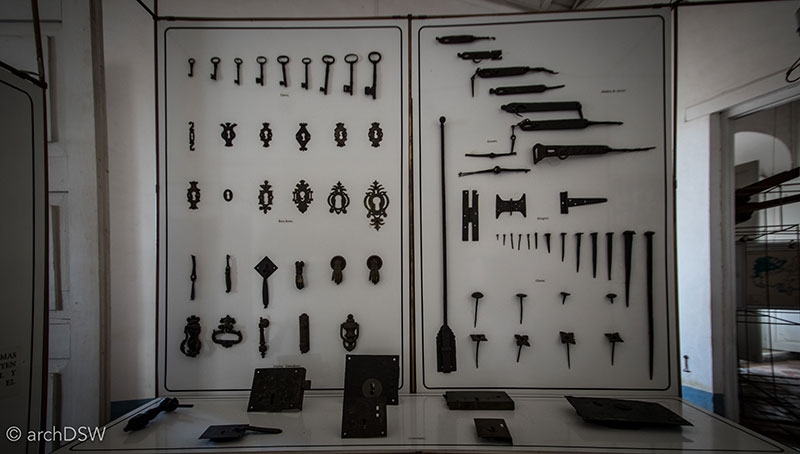
Figures 23-25. The building and the collections work together to illustrate the history and details of Cuban architecture during the colonial period.
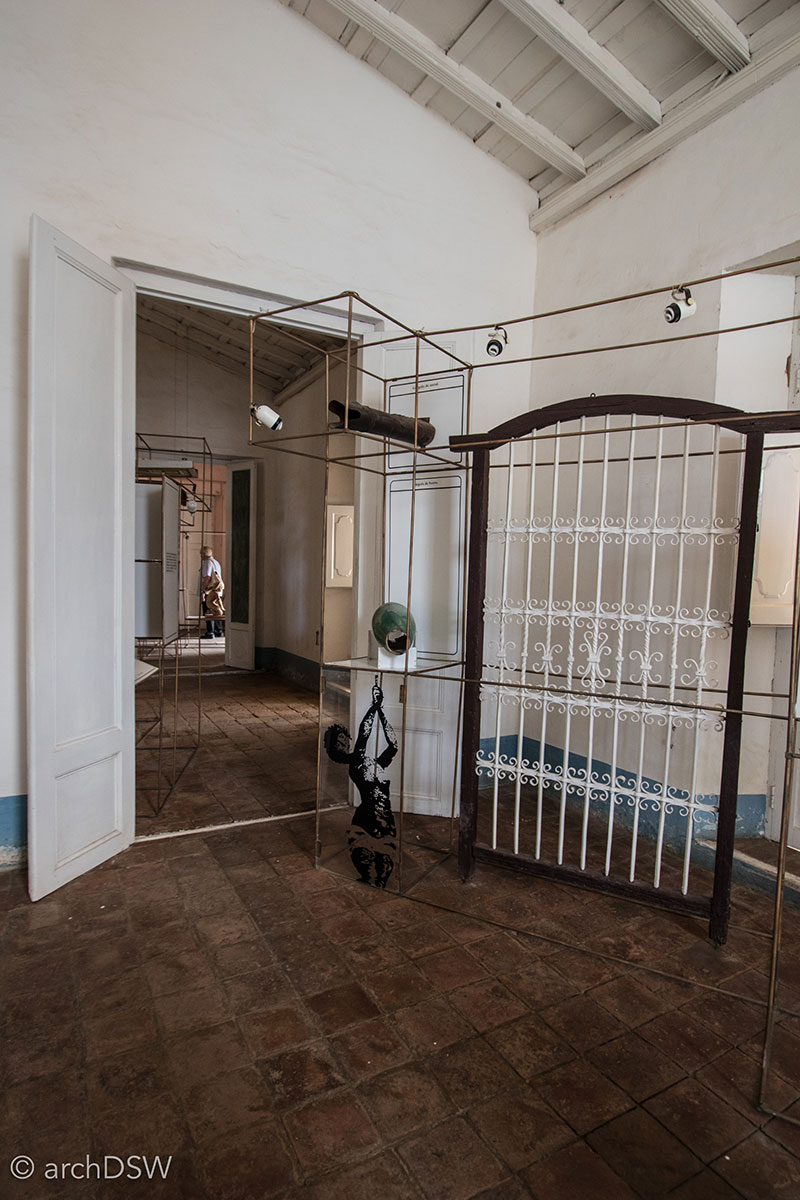
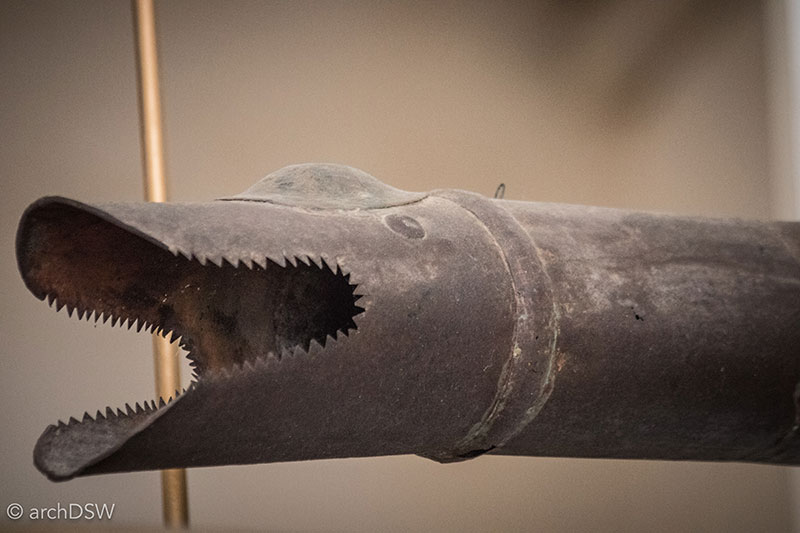
Figures 26 and 27. The objects within the architecture museum’s interpretive displays hang from metal framework, placing the collections in specific spatial arrangements that allow visitors to understand how buildings were constructed and decorated. In this image one can see the configuration of a door and waterspout, embellished as a metal gargoyle.
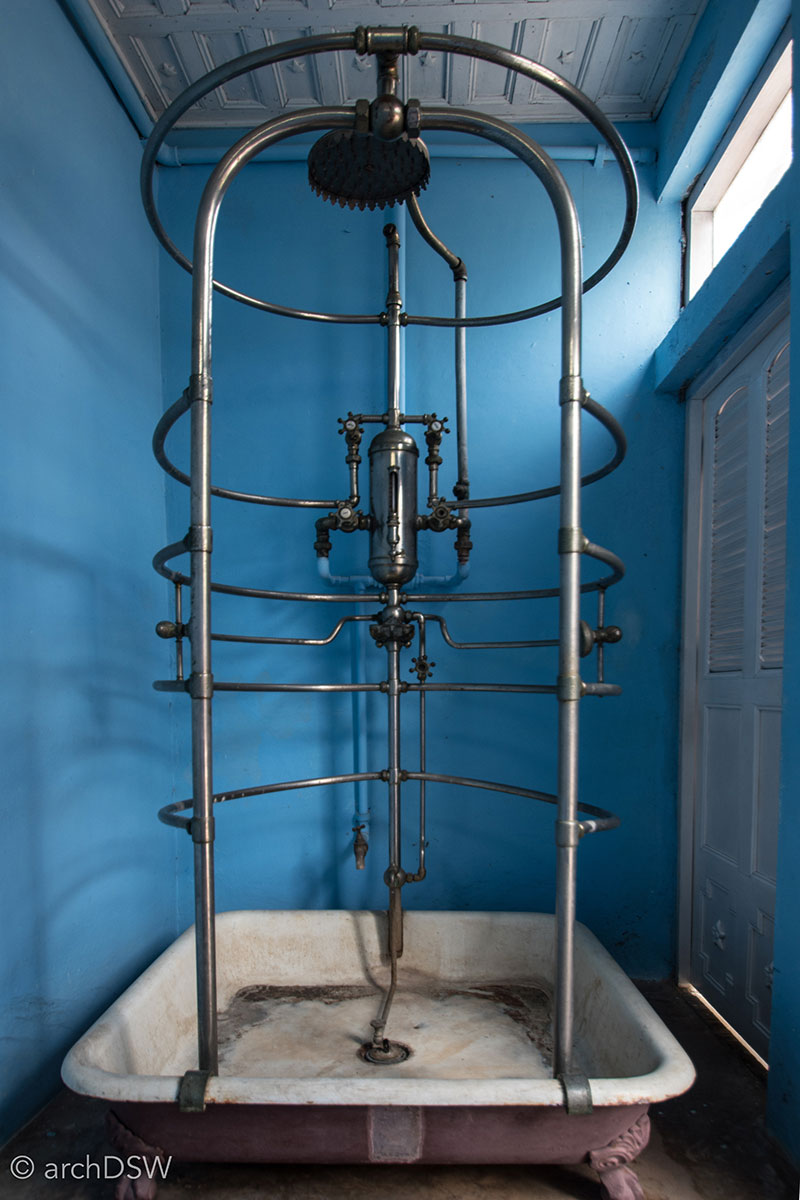
Figure 28. In the courtyard of the museum, small rooms have been converted into display spaces for preserved, 19th century pieces of domestic convenience such as decorated ceramic toilets and this elaborate shower, made in New York.
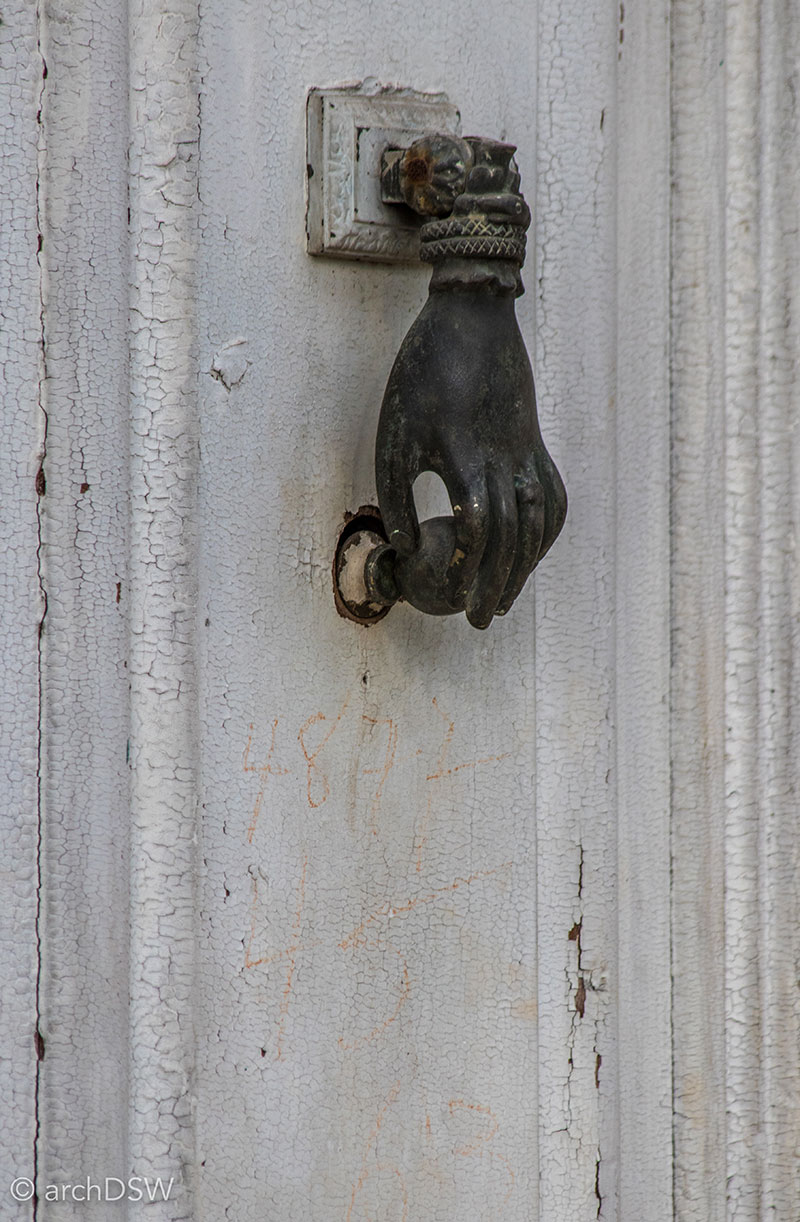
Figure 29. The architectural museum in Trinidad featured a few of these personified bronze doorknockers but the one shown in this photograph still adorns a working residence in Pinar del Rio.
Although not officially designated architectural museums, Sanitago de Cuba’s Casa de Diego Velázquez (1516–1530) is a prime example of the Mudéjar (Moorish) style (Figures 30–33) and Pinar del Rio’s Palacio Guasch (1909) is an eclectic wonder (Figures 34–37). Period furnishings, original wooden ceiling and screens, and preserved interior and exterior tile work bolster the historic character of the Casa de Diego Velázquez whereas Palacio Guasch is one of Cuba’s many examples of an early 20th-century house museum. Built by a well-traveled physician, the Palacio Guasch was a cabinet of curiosities, covered in architectural crustaceans, and was, appropriately, converted into a regional museum of natural history in 1979.
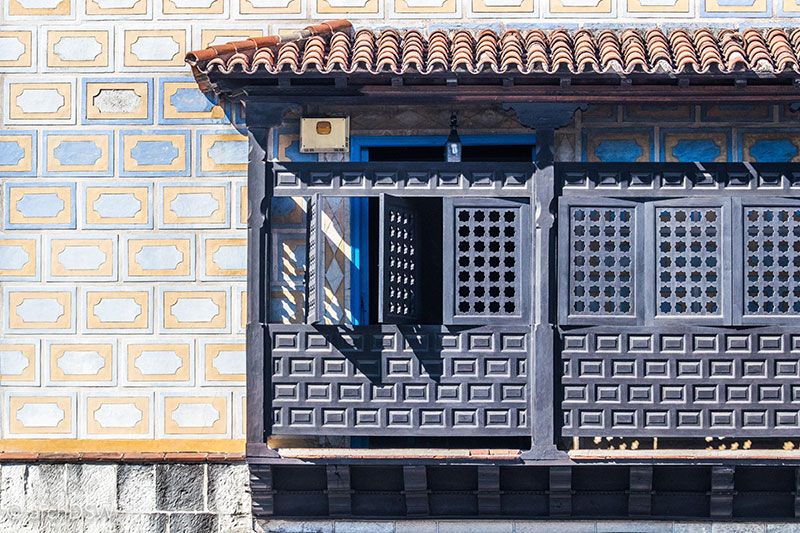
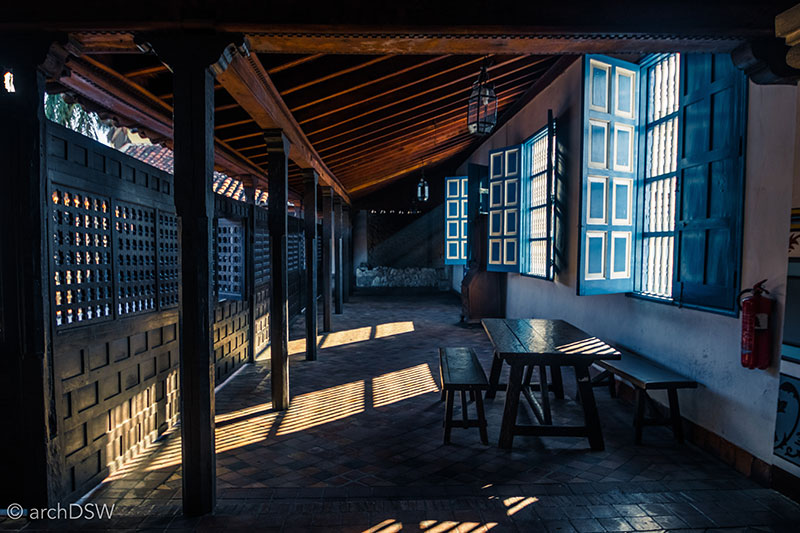
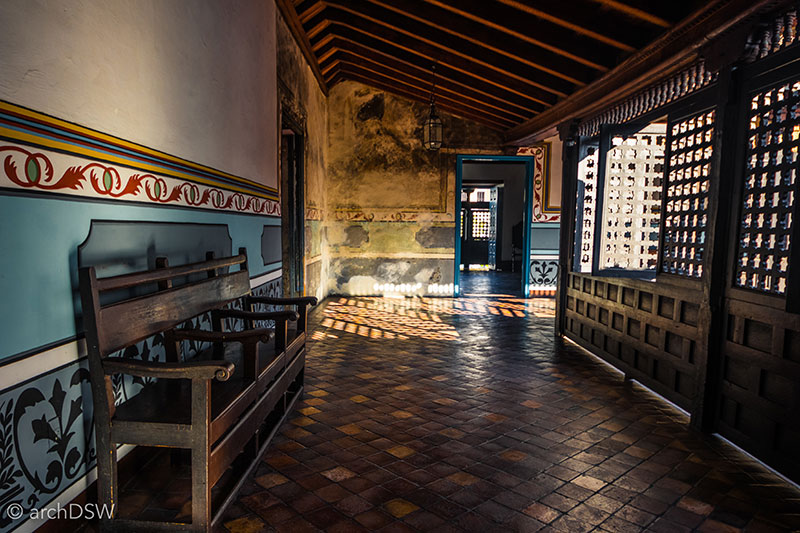
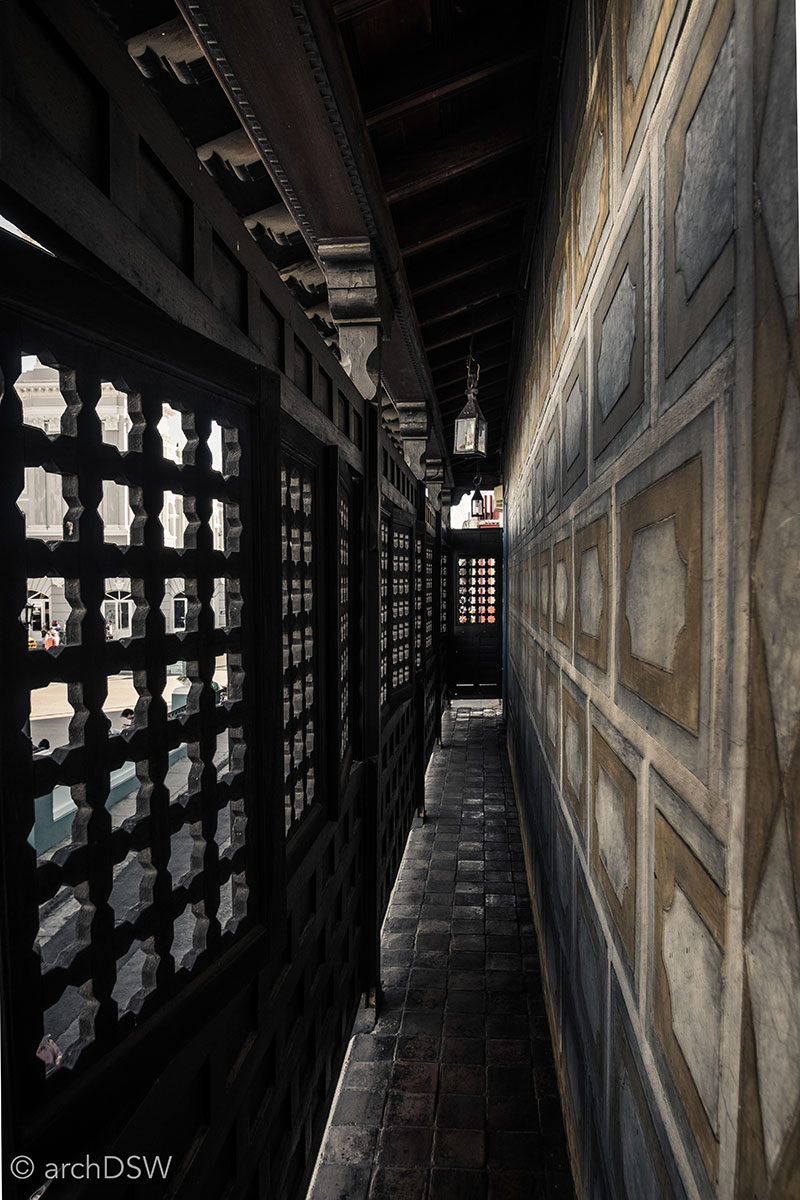
Figures 30–33. Originally restored in 1965 by architect Francisco Prat Puig, the museum claims to be the oldest extant domestic structure in the nation.
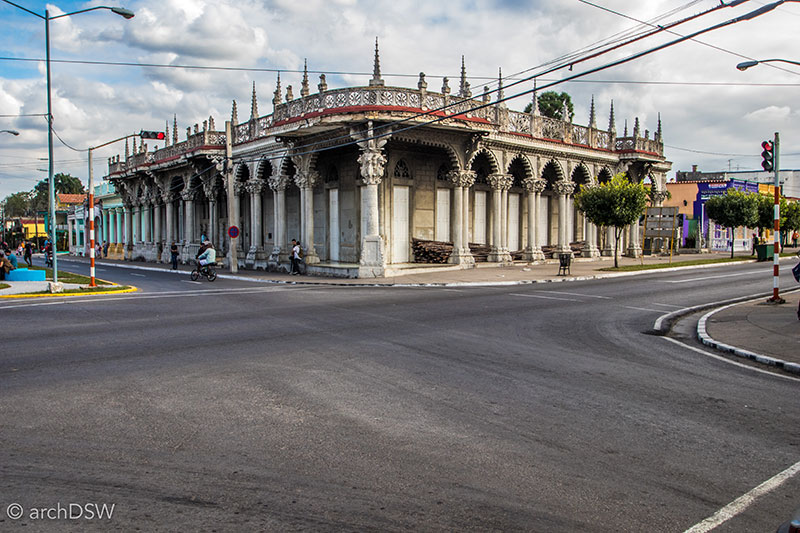
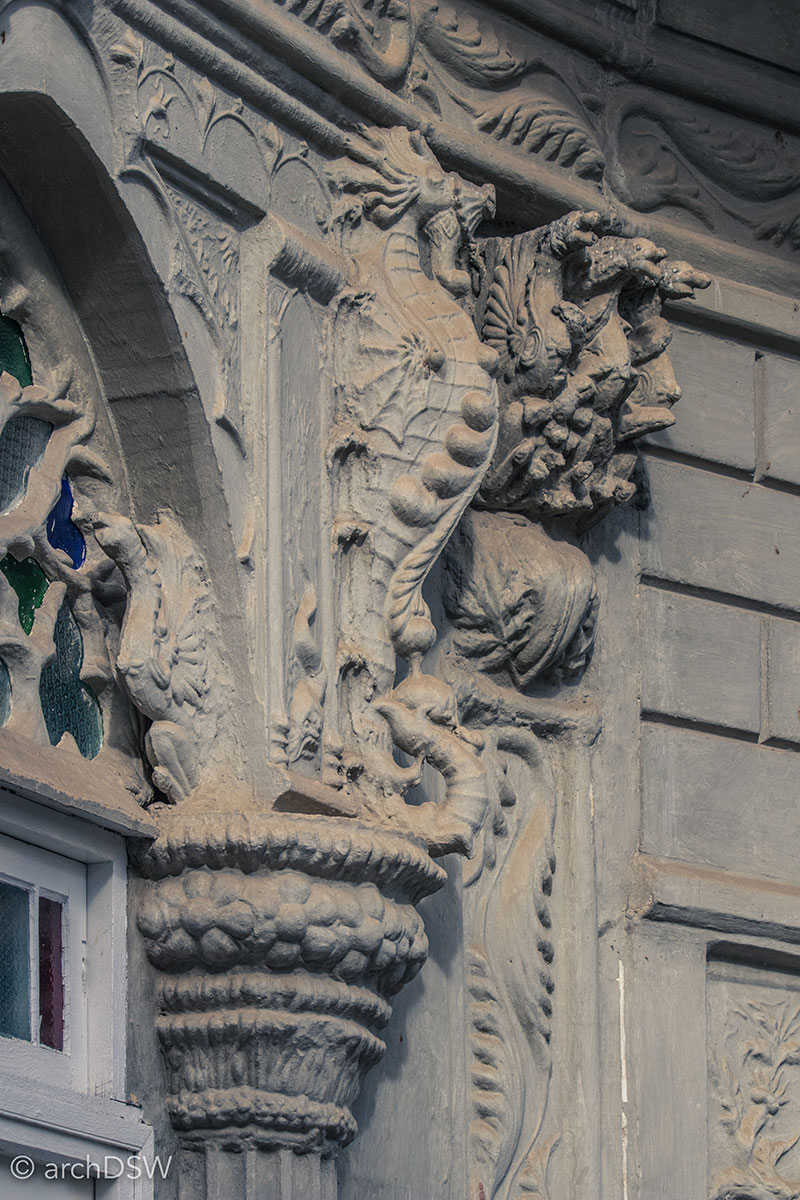
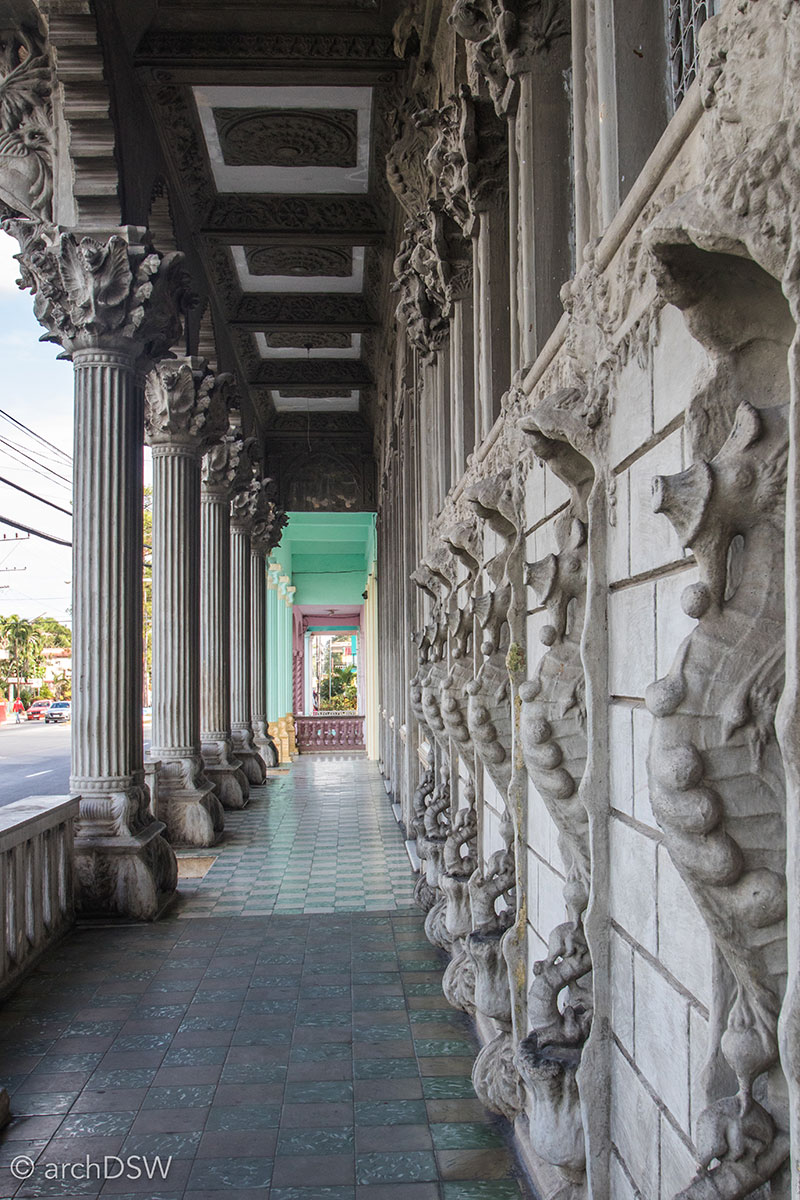
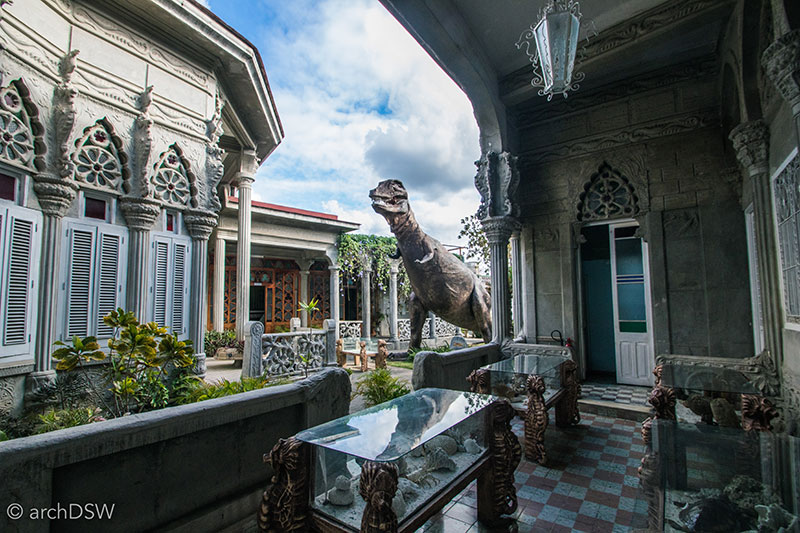
Figures 34–37. Curious details and collections fill the small museum in Palacio Guasch, Pinar del Rio.
In Camagüey, the Casa Natal Ignacio Agromonte, too, operates as a de facto architectural museum. Although this museum’s three stories of illustrated exhibits mainly focus on one of Cuba’s leaders, killed in battle, during the early years of the struggle for independence from Spain, the building also serves as an significant object in the site’s preserved collection of 19th century domestic life in Cuba. For example, the courtyard provides one of the few accessible examples of water management from the era: the courtyard contains a network of tinajones, the region’s signature clay jars used for cisterns (Figure 38a and b).
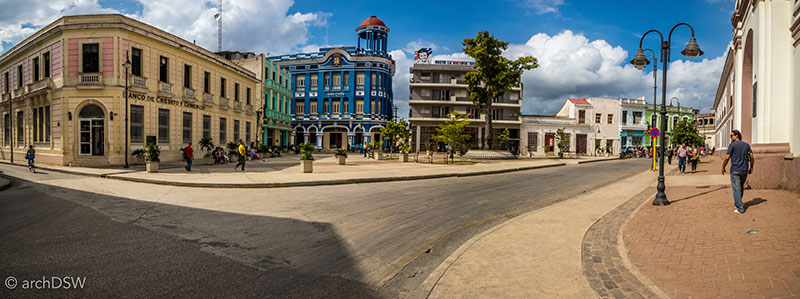
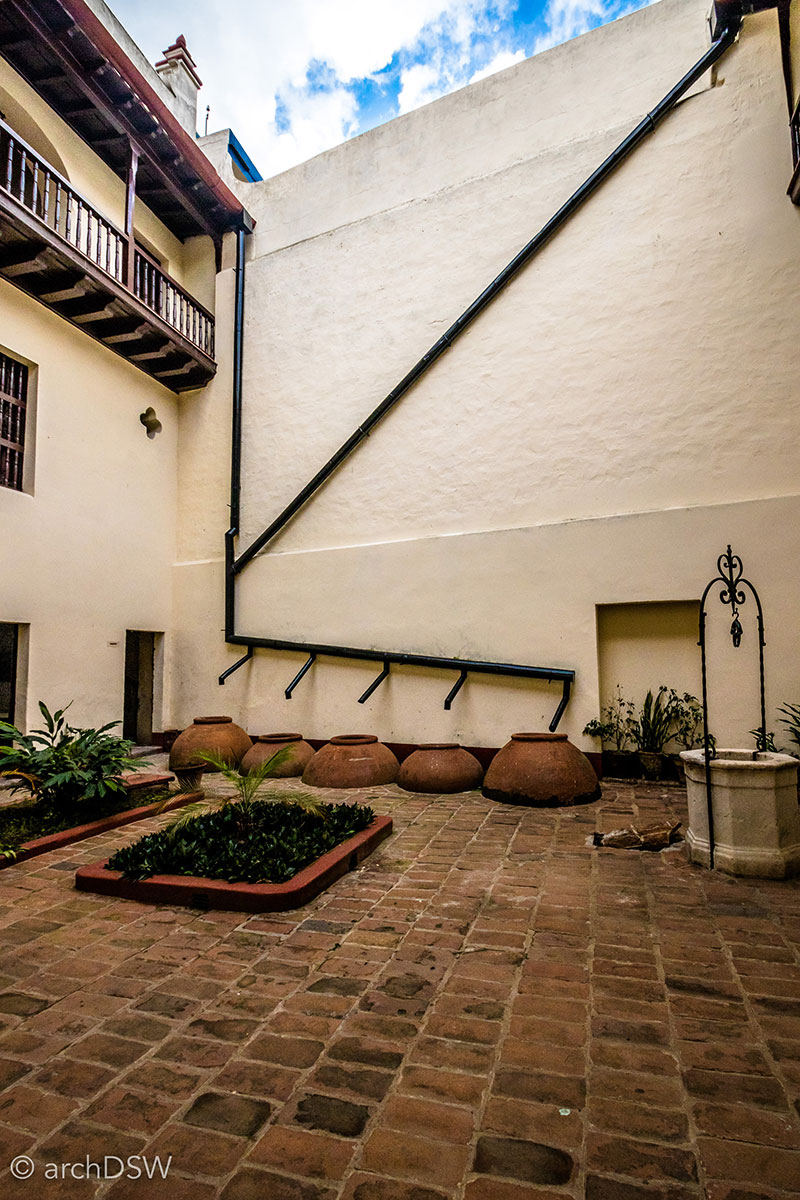
Figures 38a and b. A panoramic view of the Plaza Trabajadores in Camagüey, taken from the Casa Natal Ignacio Agromonte and view of the tinajones, used as cisterns, in the home’s courtyard.
In Havana, several grandiose homes were repurposed as public museums after the Revolution. For example, the Museo de la Revolución is the former Presidential Palace (1920), designed by Paul Belau and Carlos Maruri with interior elements by the firm of Louis Comfort Tiffany. Originally cultivated as a house-museum, the Renaissance palazzo-inspired structure near the University of Havana, now known as the the Museo Napoleonico opened to the public in 1961.The structure was designed by Cuban architects Evelio Govantes and Félix Cabarrocas and built between 1926 and 1929 as the residence for doctor and politician Orestes Ferrara Marino (1876–1972). Sugar baron Julio Lobo (1898–1983) eventually purchased the property and lived amid his extensive Napoleonic collection until he negotiated an agreement with the government of the Revolution, bestowing his collections, including a 5,000 volume library, to the nation (Figures 39–41). Like only a handful of other museums around Cuba, the significant architectural heritage of the Museo Napoleonico receives equal, interpretative attention as the museum's collection of decorative arts and historic objects.
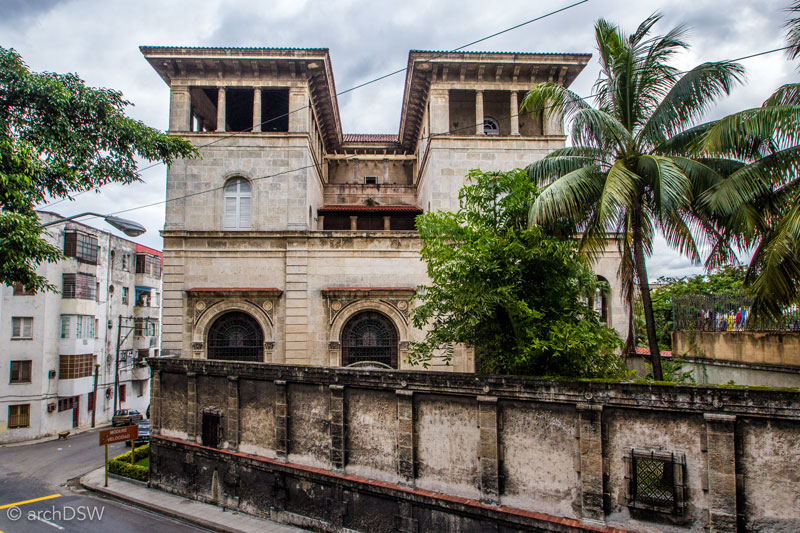
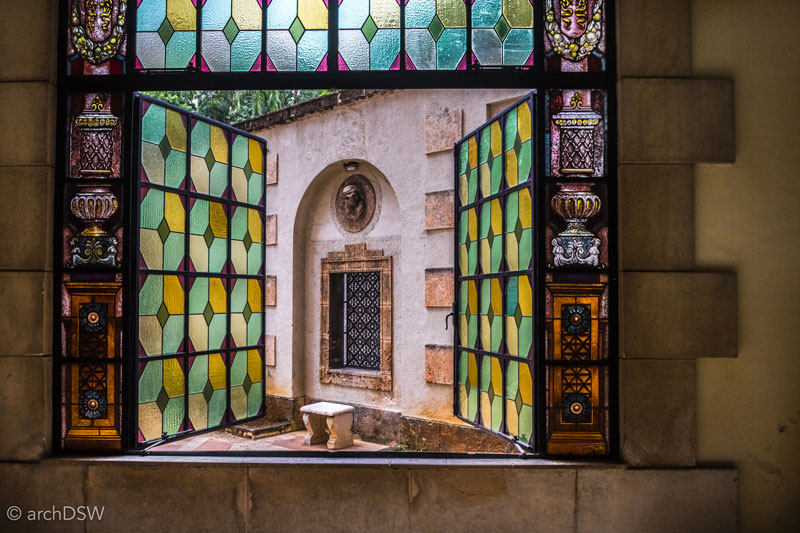
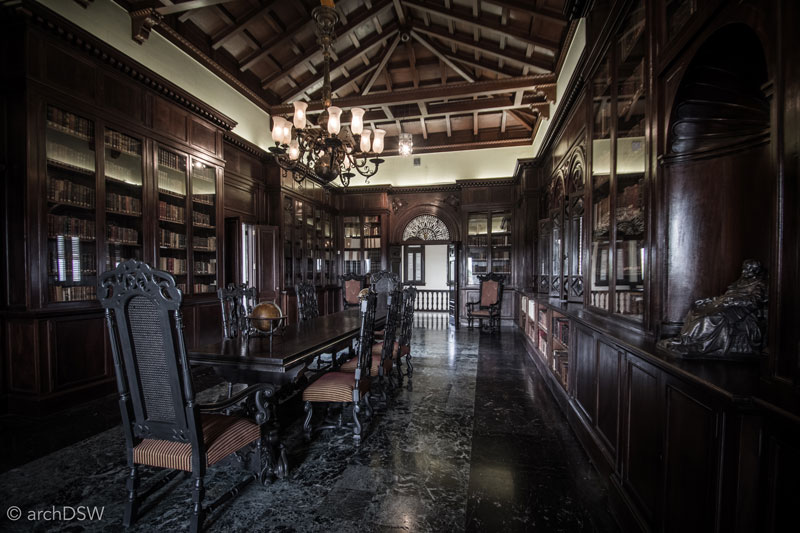
Figures 39–41. The museum contains immaculately maintained period rooms that seamlessly integrate objects from Lobo’s Napoleonic collection, such as military uniforms and weapons, furniture, letters from figures such as Marie Antoinette, and Bonaparte family portraits by Royal Academy artists such as Angelica Kauffman (1741–1807).
There are several other sites around the nation that operate as museums but do little to explain the significance of the surrounding architecture: the museum’s historic structure is seen as little more than a protective shelter and curious visitors are left to independent investigations. One such example can be found at the Museo Emilio Bacardi in Santiago de Cuba (Figures 42 and 43). Bacardi first established a museum in 1899 and commissioned a neoclassical structure to house the objects he collected from the Cuban War of Independence and his international expeditions, such as a mummy from Luxor, Egypt. Bacardi’s museum was once a light-filled atrium building with colonnaded galleries and a grand staircase but an unexplained renovation destroyed this space and transformed the museum into a building with three, divorced floors of exhibits. Although the displays have some of the best content on the island in terms of graphic design, explanatory text, and the integrated use of historic photographs, one cannot help but wonder what it was like to walk around the museum before the atrium was ‘extracted’.
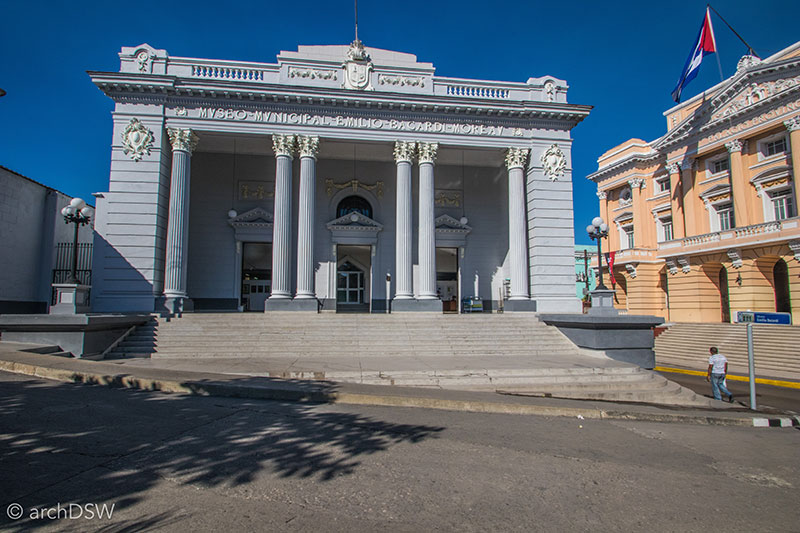
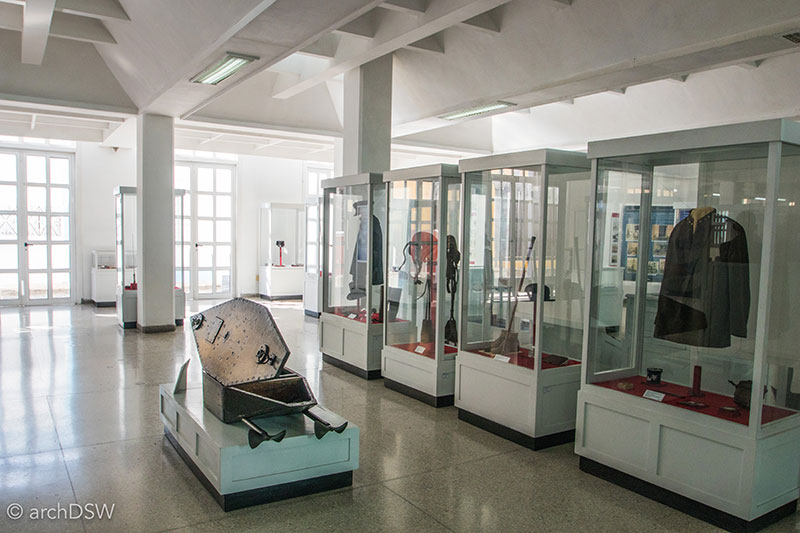
Figures 42 and 43. The form of the imposing façade of the Bacardi Museum now does little to connect to the interior spaces for the exhibits and many of the structures’ windows have been covered.
Partnerships in Preservation and Practice
Although the influx of tourists poses some challenges to the island it is also spurring much needed reinvestment in the built environment. Many of the new hotels under construction in Havana will severely impact the viewshed along the Malecón and Prado, but across the island entrepreneurs are taking advantage of regulations established in 2011 to expand the number of casa particulars [Cuban homestays]. With the salary for a typical governmental job averaging 25–30 CUCs a month, the opportunity to earn around 30 CUCs a night for a tourist’s casa particular stay is incredibly fruitful. Furthermore, the additional income from a casa particular allows property owners to renovate and restore homes, bringing new life to crumbling historic buildings. In Trinidad, I had the fortune of staying in a newly restored casa, complete with an original cedar alfarjes. This geometrically elaborate ceiling with articulated beams is one of the many places where the Spanish-Moorish architectural influence is visible on the island. Unlike Arabia, where longer pieces of lumber were rare, Cuba had a wealth of hardwoods but local Mudéjar [Spanish-Moorish craftsmen] still employed the decorative joinery found in traditional alfarjes ceiling construction (Figures 44 and 45).7
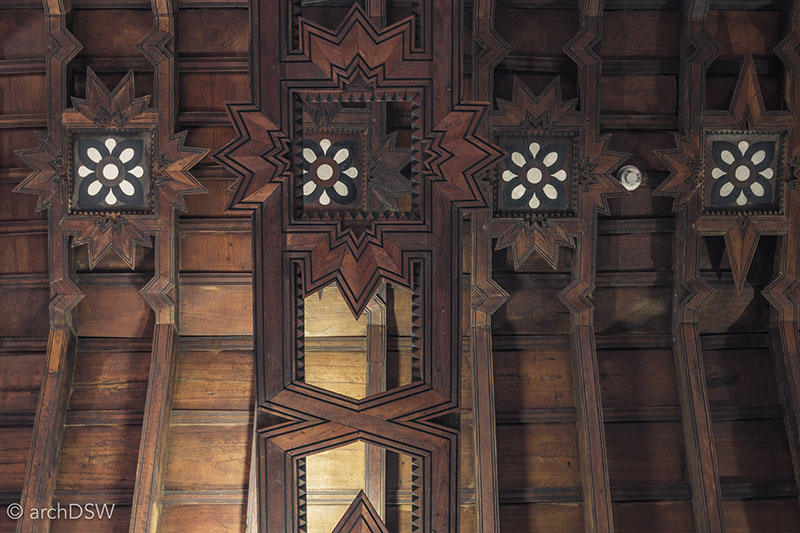
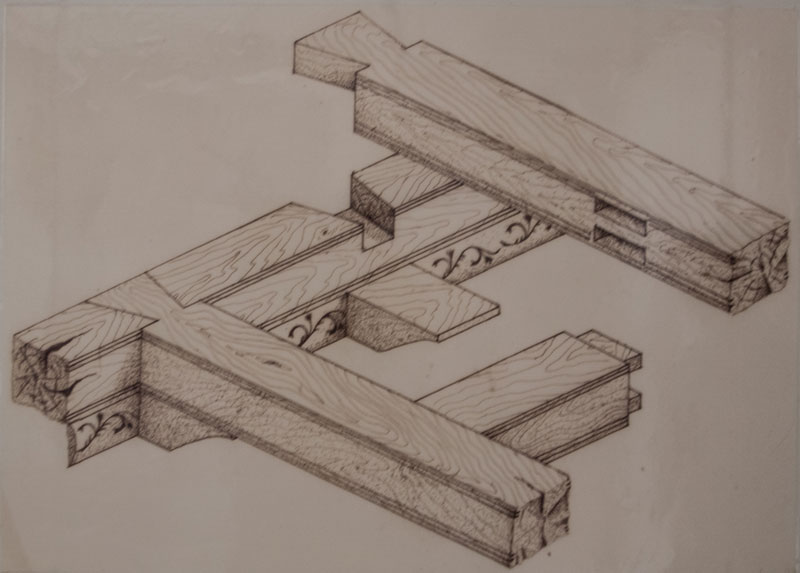
Figures 44 and 45. An example of an alfarjes in the Casa de Diego Velázquez in Santiago de Cuba followed by a diagram from the architectural museum in Trinidad, illustrating one method of joinery for the decorative ceiling construction.
The construction and renovation projects underway at residences across the island are indicative of a new type of speculative development where owners, hoping to acquire a license to operate a casa particular or paladar, can use their property to supplement incomes from state-sponsored jobs. Beyond personal profit, paladars like La Guarida, featured in the groundbreaking film Strawberries and Chocolate (1993), are bringing new life to buildings in Central Havana. This project seems to embody a philosophy of restoration found around the island: the maintenance, or replication, of elements of patina within renewed structures. For example, at La Guarida the new concrete balustrades of the terrace have a faux finish to look aged and the ongoing restoration of rooms in the multi-story structure privilege the palimpsest of wall paint over uniform surfaces while simultaneously working to stabilize, rather than replace, worn portions of marble rails and the decapitated statues on the newel posts (Figure 46).
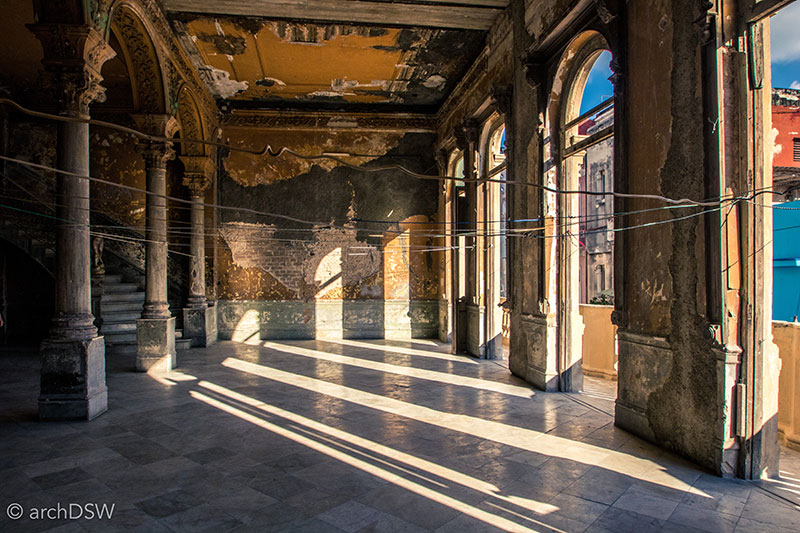
Figure 46. A view of the second story of LaGuarida, currently under restoration and the crisscrossing lines, a mixture of decommissioned electrical cords and rope lengths, are used as drying lines for the paladar’s linen napkins.
After traveling around the island for a few months, it became very clear that these projects and others could benefit from historic site documentation. Few sites have as-built drawings and even fewer have digitized documentation. As new partnerships become available on the island to encourage economic growth and educational exchange, it seems that Cuban heritage sites could significantly benefit from research partnerships between design schools and non-governmental organizations. Field schools could be developed on the island, harnessing educational and professional collaborations such as those managed by the U.S. Department of the Interior’s Historic American Building Survey (HABS), Historic American Engineering Record (HAER), or the Historic American Landscape Survey (HALS), or the practice-intensive historic conservation programs found in Europe. Such projects could bring students across island, and abroad, together to work on essential documentation and preservation. These hands-on exercises could also help bridge the professional gap between projects administered by the Ministry of Construction, the state’s governing body for architectural endeavors, and the purview of the Ministry of Culture.
The growing popularity of scholastic studies in tourism and conservation sciences at Cuba’s foremost institute of higher learning, the University of Havana, indicates that academic exchanges may be the most immediate and achievable option for bolstering the geographic range and typological scope of conservation and restoration projects on the island. Although bringing designers and students to Cuba will help foster creative collaborations, it is essential that Cuban designers and historians, too, have the opportunity to travel abroad to study alternative conservation techniques and cultural heritage tourism practices that may be beneficially adapted to Caribbean sites and climates. Some inventive, practice-based programs are already working to do this: for example, 2017 will be the inaugural year for the Cuban Architects Grant. Sponsored by the Sir John Soane’s Museum Foundation in cooperation with INTBAU Cuba, the Ludwig Foundation of Cuba and Havana Heritage, the grant will support travel, program costs, and other expenses for a Cuban architect to attend the Prince’s Foundation Summer School for Building Community.
At present, it seems that much of the preservation and conservation efforts on the island are either reactive or focused on hospitality: teams are in place at compromised structures, such as the dome of the Capitolio, or fastidiously working on projects that will facilitate tourist investment on the island. For example, the Manzana de Gómez building, a shopping mall built by sugar baron José Gómez-Mena Vila in 1910, is being converted into a new luxury hotel and the courtyards of the deconsecrated Convento de San Francisco in Havana are being restored to accommodate additional space for the religious museum (Figure 47).
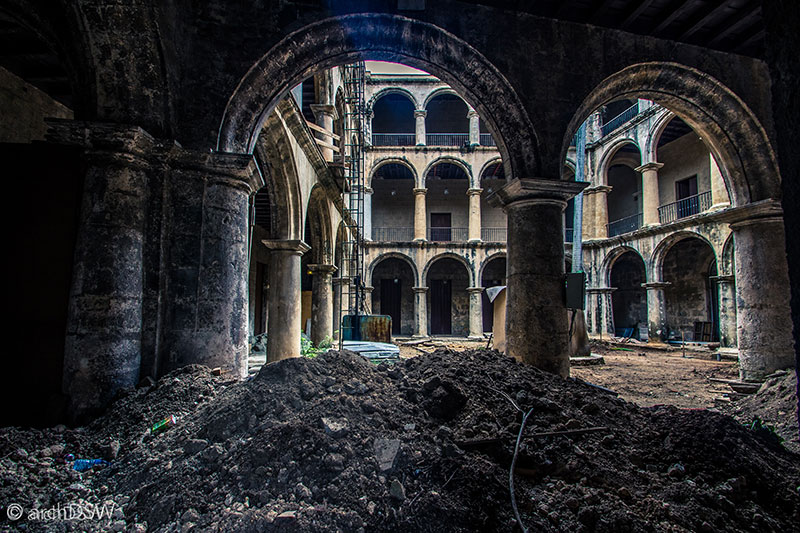
Figure 47. Scaffolding and piles of ruble cover grounds of many of Cuba’s museums, such as the trapezoidal courtyards of San Francisco seen here.
There are, of course, restoration projects outside of the categories of emergency structural assistance and state-sponsored endeavors in tourist capital, such as the recent restoration of Santiago de Cuba’s Catedral de la Asunción. Beyond the scale of the built environment, there are also new conservation projects underway, some even working within special exemptions to embargo restrictions such as the Finca Vigia Foundation’s mission to provide nearly a $1 million to support the conservation and preservation of documents within the archive of Ernest Hemingway’s Cuban home in the outskirts of Havana (Figure 48).
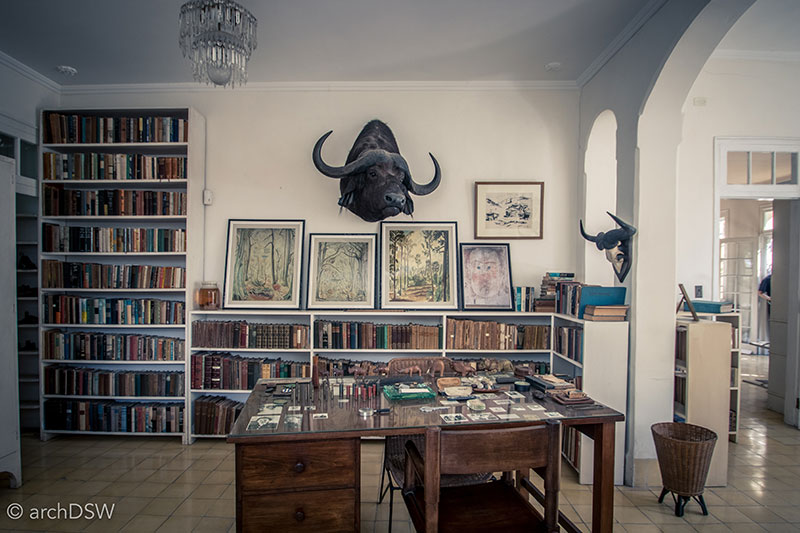
Figure 48. A view into Hemingway’s library at Finca Vigía, south of Havana.
Nonetheless, it seems that the nation needs a new wave of domestic and civic architecture restoration projects. These will be essential to the success of the current commercial renovation projects underway: if the conditions of the average Cuban home, educational institutions, and recreational facilities continue to decline, the island’s sustainable communities and workforce infrastructure will collapse (Figures 49–52).
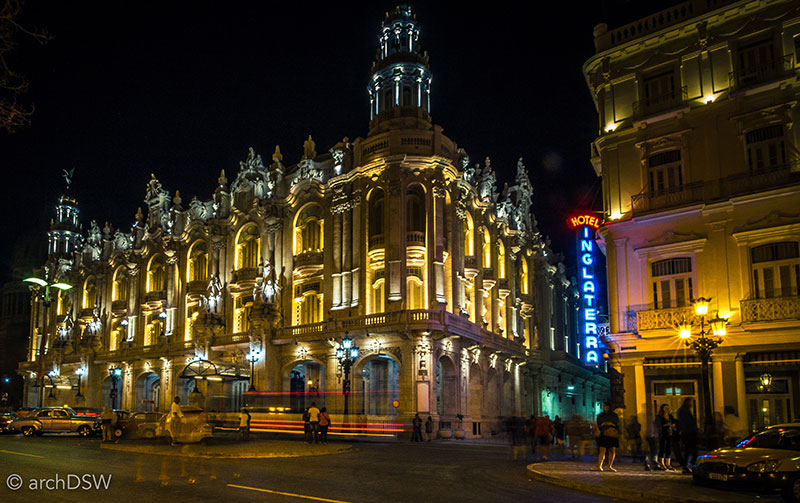
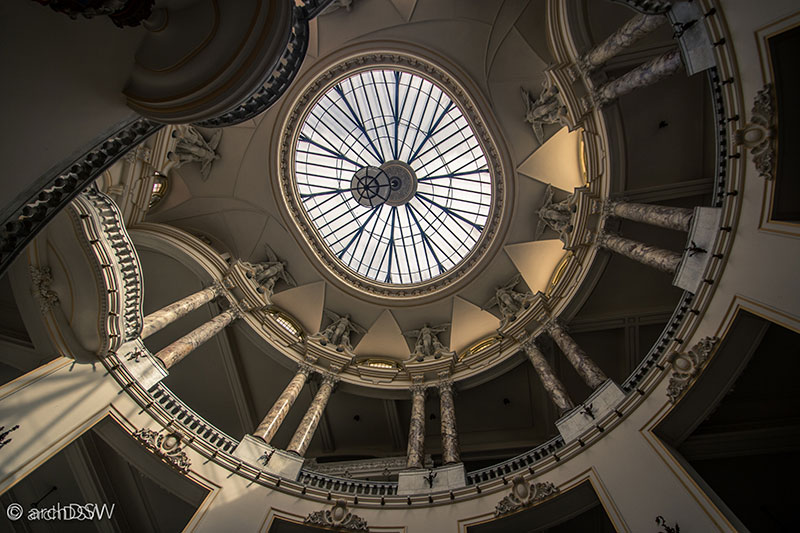
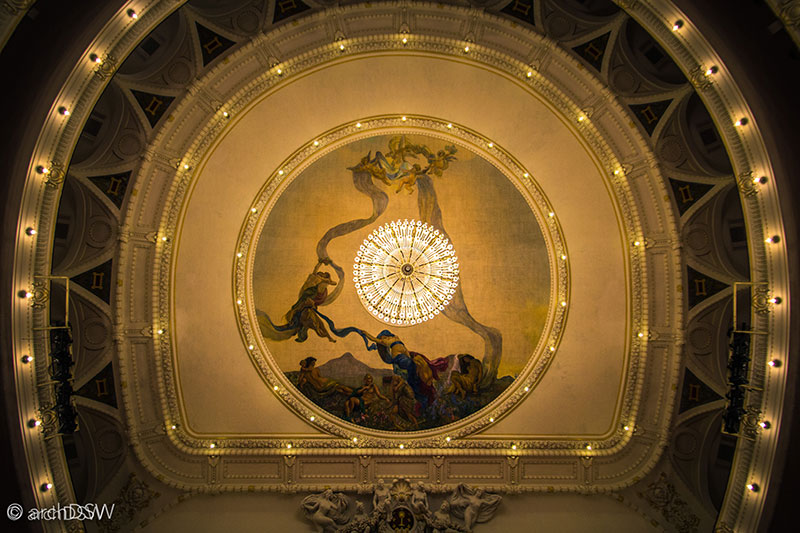
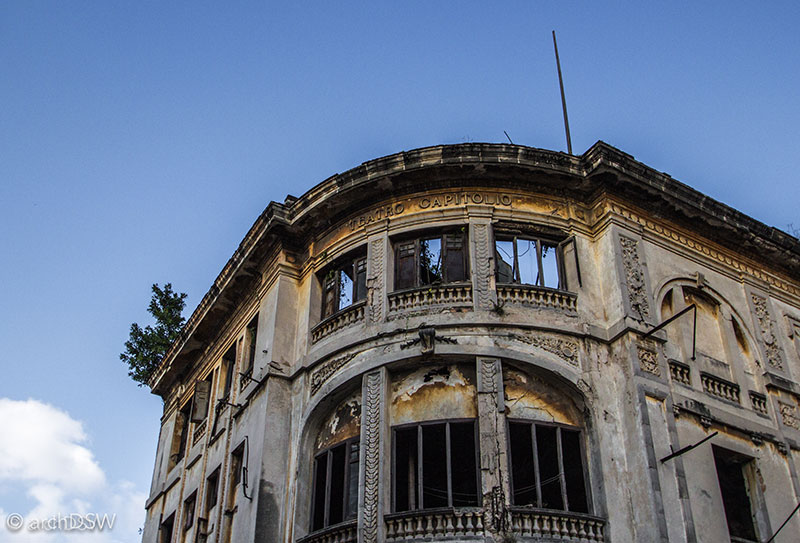
Figures 49–52. Last January, the Gran Teatro opened to much fanfare following a lengthy restoration but just behind this gem is the shell of the crumbling Teatro Capitolio.
Cuba in the 21st Century
I managed to travel a significant portion of the island and value the time spent in each place, but I am regretful that I did not manage to travel to a few sites, especially Matanzas and the panopticon Model Prison on the Isla de la Juventud. Interruptions due to weather, the effects of Hurricane Matthew, and state-imposed mourning for Fidel Castro, as well as the general complications of travel in Cuba, changed a few plans but these lost excursions also provide ample reasons for returning to the island in a few years to see what, I hope, will be positive development for the nation’s economy and its people. The overreliance on speculative development and restoration for tourism, fueling the conversion of homes into paladars and casa particulars threaten to introduce a new form of urban segregation in cities, as already witnessed in certain neighborhoods of Trinidad.
The island will also need to address the current tensions in its approach to sustainability. Generally, Cuba is a landmark example for the concept of ‘recycle and reuse’, as evidenced by inventive approaches to maintenance for cars, homes, and everyday objects (Figure 53). The island has always relied on conscientious water collection and reuse practices but the state has recently adopted certain resource and energy-saving initiatives, such as the use of compact fluorescent bulbs throughout public buildings and urban projects. Nonetheless, Cuba still needs to address the reliance on fossil fuels for energy needs as well as the use of a fleet of personal and communal vehicles that operate with pre-1970s diesel and gasoline engines, releasing clouds of black smoke into the streets (Figure 54).
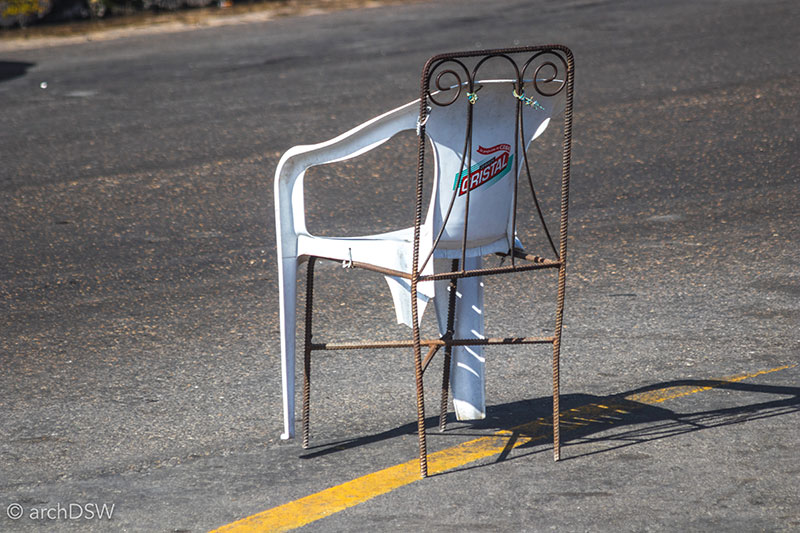
Figure 53. A parking attendant’s chair on the Paseo del Prado in Havana, made from a patchwork of plastic and welded rebar.
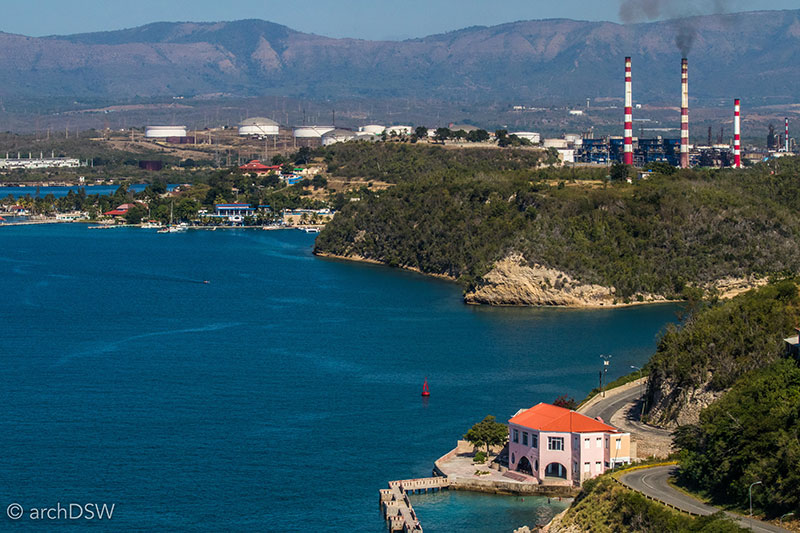
Figure 54. A view of one of the expansive oil refineries in the bay of Santiago de Cuba, as seen from the top of El Morro.
Of the seven main objectives issued in the Caribbean Action Plan for World Heritage 2015–2019, all refer to aspects of the triple bottom line sustainability: people, planet, and profit.8 The plan underscores the need to mitigate climate change, engage in practices of sustainable tourism, and invoke networks and systems that support both capacity building and community participation. One only needs to witness the frequency of rolling brownouts, sewer cleaning trucks, and fresh water supply trucks in the core of the capital to question how the capital, and nation as a whole, will be able to support the energy and service loads from existing hotels and theatres let alone the new, large-scale projects, such as the ‘six star’ Hotel Packard revival by Rafael Moneo. Nonetheless, with initiatives like Caribbean Action Plan, Cuba is participating in a more open dialogue about tourism, heritage, and shared resources.
A Traveler’s Notes
Since a primary focus of my experiential research sponsored by the H. Allen Brooks Travelling Fellowship is cultural heritage tourism, it seemed apropos to conclude this post, and my time in Cuba, with a few practical notes and suggestions for any readers who hope to visit the island in the near future:
- Make time to explore the island outside beyond Havana. The capital is large and has a wealth of historic sites as well as amazing architecture. However, if you have the time, make sure that you explore one of Cuba's other, smaller cities. These provide useful perspective on the scale and modernity of the capital while simultaneously offering the opportunity to see incredible landscapes and preserved, colonial structures.
- Explore the island’s small museums. There are incredible museums dedicated to the arts in Havana but the smaller sites dedicated to specific historical figures and events, and even chocolate, are not to be missed. In smaller sites, especially outside of Havana, it can be very useful to talk to the on-site guides and, frequently, the curator is readily available to answer questions for curious visitors.
- Stay in a casa particular. There are numerous hotels around the major cities but these are often booked well in advance with large groups through tour agencies and they can be quite costly. A stay within a casa particular is an ideal way to explore the island’s domestic architecture firsthand and have quite meaningful people-to-people exchanges with some of Cuba’s most hospitable and knowledgeable entrepreneurs. Casas can be booked on-site, and often even on the day of arrival, but it is also possible to make reservations in advance through Airbnb, launched in Cuba in the summer of 2016 and now one of the company’s most rapidly growing markets. Rooms, on average, are $30 a night and once at the casa, take advantage of the additional 5 CUC charge per day for the best breakfast you will have on the island.
- Avoid a car rental. In Cuba, traffic accidents result in criminal charges if there are injuries or damage to property. Many of the island’s roads are in poor condition and although the bus and taxi drivers seem to navigate easily, this environment can prove a dangerous one for foreigners when combined with the fact that general navigation is difficult: few cars, bikes, or motorcycles have working headlights, streets signs are rare, and unless one splurges on a pricy cellular roaming plan, there is no such thing as real-time driving directions. Additionally, highways typically have an array of roadside vendors, pedestrians, and non-motorized vehicles. Instead of taking a car, try the adventure of traveling in a cooperative taxi (Video 4) or a Cuban bus: this is a wonderful way to meet locals and other travelers while seeing the countryside (Videos 5–8).
- Download essential apps and data before arriving to the island. Outside of the wireless options of select hotels, the internet can be difficult to locate and the bandwidth is very limited. At the present time, many educational portals, web editors, and online commerce sites are restricted. For example, sites like Canvas would not load and downloads from Apple’s App store were blocked unless one used a VPN. For real-time navigation in cities and marking specific sites on a digital, vector-based platform, the offline GPS app Galileo was invaluable.
- At the present moment, some of the most basic items can be in short supply in Cuba or sold at an inflated cost as ‘luxury’ items. Articles in travel magazines and newspapers often mention that simple toiletries can be very advantageous gifts for hosts but other non-consumables can be useful too. Tennis balls were light, easy to carry, and very popular with the children I encountered when sketching or wandering through a city’s off-beaten streets. For anyone working with educators, students, or entrepreneurs on the island, USB jump drives are useful.
Video 4. A drive in one of Cuba’s signature, classic cars, traveling from Holguín to the archeological site of El Chorro de Maíta and to the northeastern shores of Guardalavaca.
Video 5. Scenes from the Viazul bus, traveling from Santiago de Cuba to Camagüey.
Video 6. Scenes from a Transtur bus, traveling from Havana to Pinar del Rio.
Videos 7 and 8. Scenes from a Transtur bus, traveling from Pinar del Rio to Cienfuegos.
Bibliography
"Caribbean Action Plan for World Heritage 2015–2019." Havana: Caribbean Member and Associated States, UNESCO, and World Heritage Committee (ICOMOS, IUCN and ICCROM), 2014.
Carley, Rachel. Cuba: 400 Years of Architectural Heritage. New York, NY: Whitney Library of Design, 1997.
Castilo, Ornaldo Gutiérez and Nélida Gancedo Gasarr. "Tourism Development for the Cuban Economy." Tourism winter (2002).
Coyula, Miguel ""The History of Havana"." In Design Leadership Network and Sir John Soane Museum Foundation Travels. Casa Catalina Lasa, Havana, 2016.
1 See the interactive map and associated links at http://whc.unesco.org/en/statesparties/cu
2 See Ornaldo Gutiérez and Nélida Gancedo Gasarr Castilo, "Tourism Development for the Cuban Economy," Tourism winter (2002).
3 Miguel Coyula, ""The History of Havana"," in Design Leadership Network and Sir John Soane Museum Foundation Travels (Casa Catalina Lasa, Havana2016).
4 Rachel Carley, Cuba: 400 Years of Architectural Heritage (New York, NY: Whitney Library of Design, 1997), 55.
6 Since there is little published information on smaller museums and their interpretation, much of the information in the following section is from the actual display boards in the museums. Throughout my travels, I have been heavily reliant on an incredible app called CamScanner to capture images from museums and subsequently generate annotated and organized PFDs. If any readers would like to see captures from specific sites, please contact me by posting a note in the comments section of the blog or by emailing.
8 The plan refers to thirty-five islands and the mission of the Caribbean States Parties is to set common objectives and expected outcomes. See the "Caribbean Action Plan for World Heritage 2015–2019," (Havana: Caribbean Member and Associated States, UNESCO, and World Heritage Committee (ICOMOS, IUCN and ICCROM), 2014).



Leave a commentOrder by
Newest on top Oldest on top